铁道机车车辆相关英语翻译
- 格式:doc
- 大小:78.00 KB
- 文档页数:7
![铁路机车常用英文词汇[整理版]](https://uimg.taocdn.com/152784ffb9f67c1cfad6195f312b3169a451eab5.webp)
铁路机车常用英文词汇机车种类types of locomotive蒸汽机车steam locomotive内燃机车;曾用名"柴油机车" diesel locomotive电力机车electric locomotive燃气轮机车gasturbine locomotive动车组motor train unit;motor train set动车motot car拖车trailer铁路干线机车railway trunk line locomotive工矿机车industrial and mining locomotive客运机车passenger locomotive货运机车freight locomotive;goods locomotive调车机车shunting locomotive;switcher小运转机车locomotive for district transfer;transfer locomotive train路用机车locomotive of service train;service locomotives配属机车allocated locomotive非配属机车un-allocated locomotive支配机车disposal locomotive非支配机车un-disposal locomotive运用机车locomotive in operation检修机车locomotive under repairing备用机车locomotive in reserve封存机车locomotive stored up待修机车locomotive waiting for repair机车出租leased locomotive机车报废locomotive retirement机车储备locomotive reservation;locomotive storage机车整备locomotive servicing;locomotive running preparation机车整备能力locomotive service capacity机车技术规范locomotive technical specification转向架中心bogie pivot center转向架中心距离distance between bogie pivot centers;bogie pivot pitc h机车全轴距locomotive total wheel base机车转向架轴距locomotive wheel base of bogie机车固定轴距locomotive rigid wheel base机车长度locomotive overall length机车宽度locomotive width机车高度locomotive height机车计算重量calcuated weight of locomotive机车整备重量locomotive service weight机车重量locomotive weight机车粘着重量locomotive adhesive weight轴重转移;轴荷载转移axle load transfer粘着重量利用系数adhesive weight utility factor机车重量分配weight distribution of locomotive轮对横动量lateral play of wheel set机车噪声locomotive noise热值;发热量heat value机车万吨公里能耗energy consumption per 10;000 t-km of locomotive机车用煤coal for locomotive机车用柴油diesel oil for locomotive机车用电electricity for locomotive机车用换算煤converted coal for locomotive标准煤standard coal机车用润滑剂lubricant for locomotive给水water supply水鹤water crane给水处理water [supply] treatment炉内软水water softened in boiler炉外软水water softened out of boiler软水water softened净水water purified机务段locomotive depot机车运用段locomotive running depot机车检修段locomotive repair depot机车折返段locomotive turnaround depot列车无线电调度系统train radio dispatching system机车监控记录装置locomotive supervise and record apparatus机车故障locomotive failure机车牵引特性locomotive tractive characteristic机车效率total locomotive efficiency机车轮周效率efficiency of locomotive at wheel rim机车传动功率transmission efficiency of locomotive机车牵引特性曲线locomotive tractive characteristic curve机车轮周功率曲线locomotive power curve at wheel rim机车牵引力曲线locomotive tractive effort curve机车预期牵引特性曲线predetermined tractive characteristic curve of locomotive机车功率locomotive power轮周功率output power at wheel rim比功率power/weight ratio比重量weight/power ratio单位体积功率specific volume power机车牵引力locomotive teractive effort轮周牵引力tractive effort at wheel rim车钩牵引力tractive effort at coupler;drawbar pull起动牵引力stsrting tractive effort粘着牵引力adhesive tractive effort持续牵引力continuous tractive effort基本阻力basic resistance运行阻力running resistance惰行阻力idle runing resistance;coasting resistance起动阻力starting resistance附加阻力additional resistance坡道阻力gradient resistance曲线阻力curve resistance空气阻力air resistance单位阻力unit resistance;specific resistance换算阻力;加算阻力converted resistance速度控制系统speed control system加速acceleration减速deceleration恒速constant speed加速力acceleration force减速力deceleration force列车制动train braking制动方式brake mode空气制动air brake真空制动vacuum brake动力制动dynamic brake液力制动hydraulic brake电阻制动rheostatic brake再生制动regenerative brake电空制动electropneumatic brake蓄能制动energy-storing brake涡流制动eddy current brake磁轨制动electromagnetic rail brake踏面制动tread brake盘型制动disc brake机车制动周期locomotive braking period机车制动距离locomotive braking distance机车每轴闸瓦作用力brake shoe force per axle of locomotive制动braking常用制动service braking;service application最大常用制动;常用全制动full servive braking;full service appli cati on阶段制动graduated application自然制动unintended braking;undesired braking紧急制动emergency braking;emergency application意外紧急制动undesirable emergency braking;UDE缓解release直接缓解;一次缓解direct release阶段缓解graduated release自然缓解unintended release;undesired release漏泄leakage充风;充气charging阶段提升graduated increasing保持位suppression;maintaining position;holding position 制动管减压量brake pipe pressure reduction过量减压over reduction局部减压local reduction分段减压split reduction最大常用减压full servive reduction常用局减quick service紧急局减quick action前后风压差false gradient列车管压差train pipe pressure gradient保压停车stopping at maintaining position缓解停车stopping at release缓解波速release propagation rate制动波速braking propagation rate机车制动机locomotive brake gear空气压缩机air compressor调压器pressure regulator给风阀feed valve减压阀reducing valve机车分配阀locomotive distributing valve切换阀transfer valve自动制动阀automatic brake valve单独制动阀independent brake valve滤尘止回阀strainer check valve机车紧急放风阀locomotive emergency vent valve高压保安阀high pressure safety valve低压保安阀low pressure safety valve无载起动电空阀no-load starting electropneumatic valve油水分离器oil-water separator总风缸main air reservoir空气干燥器air dryer撒砂装置sanding device砂箱sand box撒砂阀sanding valve撒砂器sandingsprayer紧急撒砂emergency sanding自动撒砂automatic sanding间隙效应slack actionL/V比值L/V ratio弓网关系pantograph-contact line relation机车牵引区段locomotive tractive district机车交路locomotive routing单肩回交路single-arm routing双肩回交路double-arm routing半循环交路semi-loop routing循环交路loop routing环形交路circular routing短交路short routing长交路long routing直通交路through routing机车乘务制度locomotive crew working system机车包乘制system of assigning crew to designated locomotive机车轮乘制locomotive crew pooling system机车随乘制locomotive caboose crew system机车乘务组locomotive crew司机driver副司机assisant driver指导司机driver instructor司炉fireman机车运用指标index of locomotive operation机车出入段作业preparation of locomotive for leaving and arri vi ng at depot机车全周转complete turnround of locomotive机车在段停留时间detention time of locomotive at depot机车全周转距离diatance of one complete turnround of locomotive机车全周转时间period of one complete turnround of locomotive机车走行公里locomotive running kilometers换算走行公里converted running kilometers沿线走行公里running kilometers on the road辅助走行公里auxiliary running kilometers本务走行公里leading locomotive running kilometers单机走行公里light locomotive running kilometers重联机车走行公里multi-locomotive running kilometers机车日车公里average daily locomotive running kilometers机车平均牵引总重average gross weight hauled by locomotive机车日产量average daily output of locomotive运用机车台数number of locomotive in service机车需要系数coefficient of locomotives requirment单机运行light locomotive running双机牵引;双机重联牵引double locomotive traction多机牵引multi-locomotive traction主机;本务机车leading locomotive机车超重牵引traction for train exceed mass norm机车调度命令locomotive diapatching order机务段运行揭示running service-bulletin of depot司机运转保单driver’s service-report;driver’s log司机室driver’s cab司机操纵台driver’s desk司机模拟操纵装置simulator for driver train-handling优化操纵optimum handling;optimum optimum operation机车自动操纵automatic locomotive operation机车保养locomotive maintenance机车检修locomotive inspection and repair机车检修修程classification of locomotive repair机车大修locomotive overhaul [repair];locomotive general overhaul架修intermediate repair定修periodical repair;light repair蒸汽机车洗修steam locomotive boiler washout repair机车厂修locomotive repair in works机车段修locomotive repair in depot日常检查routine inspection机车临修locomotive temporary repair定期检修repair based on time or running kilometers状态检修repair based on condition of component换件大修component exchange repair配件互换修repair with interchangeable component预防维修制preventive maintenance system检修周期period of inspection and repair月检monthly inspection定检公里running kilometers between predetermined repairs定检时间time between predetermined repairs检修范围scope of repairing course;scope of repair超范围修理repair beyond the scope of repairing course检修停时standing time under repair集中化修理;集中修centralization of repair检修基本技术条件fundamental technical requirements for repair and inspection检修工艺规程technological regulations for repair and inspection检修作业程序repair procedure;shop program磨耗限度limit of wear检修限度locomotive repair limit第一限度1st limit第二限度2nd limit使用限度operation limit中间工艺检验intermediate inspection at the technological process转向设备turning facilities转盘turntable机务设备通过能力carrying capacity of locomotive facilities机车专用设备special equipment for locomotive operation机车验收acceptance of locomotive机车试运转locomotive trial run形式试验type test性能试验performance test鉴定试验homologation test出厂试验predelivery test制动试验brake test牵引试验traction test负载试验loaded test;load test牵引热工试验traction and thermodynamique de traction定置试验stationary test;test at standstill动力学试验dynamics test强度试验strength test运用试验service test;operation test耐久性试验durability test可靠性试验reliability test例行试验routine test特殊试验special test研究性试验investigation test抽样试验sampling test模拟试验analogue test机车履历簿locomotive logbook直流电力机车DC electric locomotive单向交流电力机车single-phase AC electric locomotive单相工频交流电力机车single-phase industrial frequency AC electric l ocomoti ve双电压制电力机车dual voltage electric locomotive双频率制电力机车dual frequency electric locomotive多电流制电力机车multiple system electric locomotive硅整流器电力机车silicon rectifier electric locomotive晶闸管整流器电力机车thyristor rectifier electric locomotive经闸管变流器电力机车thyristor converter electric locomotive电动车组electric multiple unit;motor coach set;electric motor train unit单相交流电动车组single-phase industrial frequency AC motor train unit地下铁道电动车组subway motor train unit电流制current system直流制DC system单相工频交流制single-phase industrial frequency AC system单相低频交流制single-phase low frequency AC system受电弓标称电压nominal voltage at pantograph调压方式voltage regulation mode高压侧调压high voltage regulation低压侧调压low voltage regulation分级调压stepped voltage regulation无级调压stepless voltage regulation相控调压phase control斩波调压chopper control变阻调压rheostatric control整流方式mode of rectification牵引变流器traction convertor牵引逆变器traction invertor牵引变频器traction frequency convertor可调牵引变频器variable frequency convertor直流斩波器DC chopper单相桥式整流器single-phase bridge rectifier三相桥式整流器three-phase bridge rectifier可控桥式整流器controlled bridge rectifier对称半控桥式整流器symmetric half-controlled bridge rectifier非对称半控桥式整流器asymmetric half-controlled bridge rectifier 多段桥[联结] bridges in cascade;multi rectifier bridge硅整流装置silicon rectifier device晶闸管整流装置thyristor rectifier device励磁整流装置excitation rectifier device电力传动方式mode of electric drive直流传动DC drive交-直流传动AC-DC drive交-直-交流传动AC-DC-AC drive调速方式mode of speed control变压调速variable voltage speed control变频调速variable frequency speed control变极调速pole changing speed control车轴驱动方式mode of axle drive弹性齿轮驱动resilient gear drive刚性齿轮驱动solid gear drive单侧减速齿轮驱动single reduction gear drive双侧减速齿轮驱动double reduction gear drive单电动机驱动monomotor drive车轴空心轴驱动quill drive;hollow axle drive电机空心轴驱动hollow shaft motor drive万向轴驱动cardan shaft drive直接驱动gearless drive;direct drive独立驱动individual drive组合驱动coupled axle drive连杆驱动rod drive组合传动机车coupled axle drive locomotive独立传动机车individual drive locomotive齿轨[传动]机车;齿条传动机车rack locomotive牵引电动机供电制式traction motor power supply system机车集中供电locomotive centralized power supply转向架独立供电bogie individual power supply电动机独立供电motor individual power supply主电路power circuit;main circuit高压电路high voltage circuit;high tension circuit低压电路low voltage circuit;low tension circuit网侧电路circuit on side of overhead contact line牵引电路traction circuit制动电路braking circuit滤波电路filter circuit辅助电路auxiliary circuit列车供电电路power supply circuit for train控制电路control circuit控制电源control source蓄电池电路battery circuit指令电路command circuit照明电路lighting circuit仪表电路instrument circuit联锁电路interlocking circuit信号电路signal circuit起动电路starting circuit保护电路protective circuit电子控制电路electronic control circuit电空制动电路electropneumatic brake ciucuit;E-P brake circuit防空转防滑行保护电路anti-slip/slide protection circuit音频通讯电路audio communication circuit电连接器electric coupler自动电连接器electric automatic coupler机车重联电连接器multi-locomotive electrc coupler牵引电动机traction motor直流牵引电动机DC traction motor脉流牵引电动机pulsating current traction motor交流牵引电动机AC traction motor单向交流牵引电动机single-phase AC traction motor三相交流牵引电动机three phase AC traction motor抱轴式牵引电动机axle hung traction motor;nose suspension tracti on motor架承式牵引电动机frame mounted traction motor转向架架承式牵引电动机bogie mounted traction motor底架架承式牵引电动机underframe mounted traction motor串励电动机series excited motor并励电动机shunt excited motor复励电动机compound excied motor他励电动机separately excited motor同步电动机synchronous motor异步电动机asynchronous motor交流换向器电动机alternating current commutator motor全封闭式电动机totally-enclosed motor通风式电动机ventilated motor自通风式电动机self-ventilated motor强迫通风式电动机force ventilated motor直线电动机;线性电动机linear motor直线同步电动机linear synchronous motor直线异步电动机;直线感应电动机linear asynchronous motor;linear induction motor电动机转速motor speed电动机超速runaway speed电动机特性motor characteristic电动机转矩;电动机扭矩motor torque启动转矩starting torque峰值转矩peak torque制动转矩braking torque最大输出功率maximum output启动电流starting current峰值电流peak current标称电压nominal voltage变压器电势transformer EMF片间平均电压mean voltage between segments片间最高电压maximum voltage between segments消弱磁场weakened field最大磁场maximum field最小磁场minimum field磁场消弱率field weakening磁场消弱系数coefficient of field weakening恒功调速比speed ratio on constant power转向器commutator换向片commutator segment电枢线圈armature coil均压线equalizer;cable bond转轴shaft定子stator转子rotor主极铁心mainpole core主极线圈mainpole coil换向极铁心interpole core换相极线圈interpole coil补偿线圈compensating coil机座frame铸造机座cast frame焊接机座welding frame半叠片机座semi-laminated frame全叠片机座full-laminated frame电刷装置brush gear刷握brush-holder刷盒brush box电刷brush端盖end shield抱轴悬挂装置suspension bearing主发电机main generator直流主发电机DC main generator交流主发电机main alternator辅助发电机auxiliary generator直流辅助发电机DC auxiliary generator直流启动发电机DC starting generator;dynastarter直流控制发电机DC control generator直流励磁机DC exciter劈相机Arno converter;phase splitter辅助电动机auxiliary motor直流辅助电动机DC quxiliary motor异步辅助电动机asynchronous auxiliary motor空压机电动机air compressor motor通风机电动机blower motor泵电动机pump motor控制电机control electric machine自整角机synchro测速发电机tachogenerator机车牵引变压器traction transformer of locomotive心式牵引变压器core-type traction transformer壳式牵引变压器shell-type traction transformer自藕牵引变压器traction autotransformer调压牵引变压器regulating traction transformer分接牵引变压器tapped traction transformer油浸式牵引变压器oil-immersed type traction transformer 整流变压器rectifier transformer电源变压器supply transformer隔离变压器;绝缘变压器isolating transformer同步变压器synchronous transformer脉冲变压器pulse transformer控制变压器control transformer信号变压器signal transformer励磁变压器excitation transformer高压绕组high voltage winding;high tension winding 低压绕组low voltage winding;low tension winding 调压绕组regulating winding励磁绕组excitation winding辅助绕组auxiliary winding列车供电绕组train coach supply winding自然循环natural circulation强迫循环forced circulation强迫导向循环forced guided circulation牵引电抗器traction tractor平波电抗器smoothing reactor过渡电抗器transition reactor接地电抗器earthing reactor;grounding reactor制动电抗器braking reactor分流电抗器divert shunt reactor;inductive shunt滤波电抗器filter reactor均流电抗器sharing reactor限流电抗器inductive reactor;current limiting reactor 换相电抗器commutation reactor起动电阻器staring resistor制动电阻器braking resistor过渡电阻器transistion resistor分流电阻器divert shunt resistor;shunting resistor稳定电阻器stabilizing resistor调节电阻器regulating resistor制动电阻柜braking resistor cubicle制动电阻元件braking resistor grid非线性电阻器non-linear resistor滤波电容器filter capacitor换相电容器commutating capacitor保护电容器protective capacitor起动电容器starting capacitor补偿电容器compensation capacitor主断路器line circuit-breaker真空主断路器line vacuum circuit-breaker空气主断路器line air-blast circuit-breaker直流高速断路器DC high speed circuit-breaker受电器current collector受电弓pantograph单臂受电弓single arm pantograph双臂受电弓double arm pantograph弓头pantograph bow受电弓滑板pantograph pan弓角pantograph horn受电弓气缸pantograph cylinder支持绝缘子supporting insulator第三轨受电器conductor rail collector受电靴装置shoegear集电靴collector shoe电磁接触器electromagnetic contactor直流接触器DC contactor交流接触器AC contactor电空接触器electropneumatic contactor组合接触器grouping contactor线路接触器line contactor磁场削弱接触器field weakening contactor制动接触器braking contactor励磁接触器excitation contactor辅助接触器auxiliary contactor调压开关tap changer低压调压开关low voltage tap changer;low tension tap changer高压调压开关high voltage tap changer;high tension tap changer位置转换开关position changeover switch鼓形位置转换开关drum position changeover switch凸轮位置转换开关cam position changeover switch牵引-制动位转换开关power/brake changeover switch反向器reverser电流制转换开关current system changeover switch主电路库用转换开关main circuit transfer switch for shed supply辅助电路库用转换开关auxiliary circuit transfer switch for shed supply 短路器short-circuiting device接地开关earthing switch牵引电动机隔离开关traction motor isolating switch受电弓隔离开关pantograph isolating switch主整流柜隔离开关isolating switch for main silicon rectifier cubicle劈相机故障隔离开关fault isolating switch for phase splitter控制电源隔离开关isolating switch for control supply司机控制器driver controller调车控制器shunting controller电空制动控制器E-P brake controller按键开关button switch;key switch自复式按键开关self-reset push-key switch非自复式按键开关non-self-reset push-key switch主按键开关组main button switch group;main key switch set副按键开关组secondary push-key switch group;secondary key swi tch set电磁阀electromagnetic valve电空阀clectropneumatic valve电液阀electro-hydraulic valve保护阀protective valve受电弓电空阀pantograph valve防空转撒沙电空阀anti-slip sanding valve防空转防滑行保护装置anti-slip/slide protection device轴重转移补偿装置axle load transfer compensation device功率因数补偿装置power factor compensation device电压继电器voltage relay电流继电器current relay时间继电器time relay中间继电器intermediate relay速度继电器speed relay温度继电器temperature relay压力继电器pressure relay欠电压继电器under-voltage relay过电流继电器over-current relay转速继电器tachometric relay流速继电器flow relay接地继电器earth fault relay风压继电器air pressure relay油压继电器oil-pressure relay起动继电器starting relay主电路库用插座main circuit socket for shed supply辅助电路库用插座auxiliary circuit socket for shed supply控制电路库用插座control circuit socket for shed supply重联插座multiple unit socket印制电路板插座printed circuit board socket电压调整器voltage regulator温度调整器temperature regulator位置指示器notch indicator数字显示器digital display司机室取暖电炉driver’s cab electric heater司机室热风装置driver’s cab air heater司机室空调装置driver’s cab air conditioner电热玻璃electric heating glass电测仪表electrical measuring instrument牵引电机电压表traction motor voltmeter牵引电机电流表traction motor ammeter励磁电流表excitation ammeter网侧电压表voltmeter on side of overhead contact line;overhead side voltmeter辅助电路电压表auxiliary circuit voltmeter控制电源电压表control supply voltmeter控制电源电流表control supply ammeter机车速度表locomotive speedometer单相电度表single-phase wat-hour meter速度记录仪tachograph传感器sensor;transducer电压传感器voltage sensor电流传感器current sensor压力传感器pressure sensor速度传感器speed sensor温度传感器temperature sensor直流电流互感器DC current transformer阀形避雷器valve type arrester放电器discharger轮缘喷油器flange lubricator接地安全棒earthing pole接地回流电刷earth return brush前照灯head lamp;head light副前照灯subhead lamp;dim head light标志灯marker lamp走行部灯bogie lamp车号灯side number plate lamp路签灯train staff lamp记事灯writing lamp照明灯illuminating lamp指示灯indicator lamp风喇叭air horn高音风喇叭high tone air horn低音风喇叭low tone air horn警笛siren警惕装置vigilance device机车组装后的检查与试验inspection and test of locomotive after completion of construction一般性检查general inspection称重试验weighing test压缩空气设备全面的气密性试验test for over-all air-tightness of compressed air equipments 车体及外部装备密封试验test for sealing of body and external equipment受电弓试验pantograph test介电强度试验dielectric test事故预防措施的检查checks for prevention of accidents安全设备试验test on safety equipments蓄电池充电系统试验checks of battery charging-arrangement通风冷却试验test on ventilation and cooling空气制动试验test on air brake曲线通过实验curve negotiation test机车振动参数测试measurements of vibration parameters辅助机组试验test on auxiliary machines机车调速试验test on speed regulation主电路短路保护系统试验test on short-circuit protection system of main circuit 主电路过载保护系统试验test on overload protection system of main circuit内部过电压试验test on internal overvoltage外部过电试验test on external overvoltage机车功率试验locomotive [traction] power test机车功率因数测定measurment of power factor机车效率测定measurement of efficiency of locomotive谐波电流百分比测定measurement of percentage of harmonic current起动加速试验starting and acceleration test运行阻力试验test for running resistance电气制动试验electric braking test滤尘效果试验test on filter efficiency撒沙装置试验test on sanding gear重联运行试验test on coupled operation;test on multi unit operation司机室工作条件检查check on working conditions in the driver’s cab4。
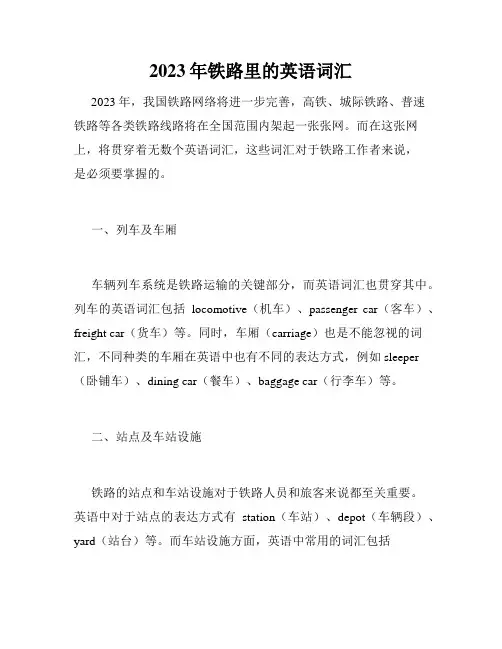
2023年铁路里的英语词汇2023年,我国铁路网络将进一步完善,高铁、城际铁路、普速铁路等各类铁路线路将在全国范围内架起一张张网。
而在这张网上,将贯穿着无数个英语词汇,这些词汇对于铁路工作者来说,是必须要掌握的。
一、列车及车厢车辆列车系统是铁路运输的关键部分,而英语词汇也贯穿其中。
列车的英语词汇包括locomotive(机车)、passenger car(客车)、freight car(货车)等。
同时,车厢(carriage)也是不能忽视的词汇,不同种类的车厢在英语中也有不同的表达方式,例如sleeper (卧铺车)、dining car(餐车)、baggage car(行李车)等。
二、站点及车站设施铁路的站点和车站设施对于铁路人员和旅客来说都至关重要。
英语中对于站点的表达方式有station(车站)、depot(车辆段)、yard(站台)等。
而车站设施方面,英语中常用的词汇包括platform(站台)、ticket office(售票处)、waiting room(候车室)等。
三、行驶中的指令和提示在铁路行驶中,有许多指令和提示需要准确传达和理解。
这些指令和提示的英语表达方式也十分丰富。
例如,toot the whistle(鸣笛)、slow down(减速)、go ahead(前进)等。
四、维修与保养随着铁路技术的不断发展,车辆和设备的维修和保养也变得越来越重要。
因此,在英语中与维修相连的表达方式也将会出现在铁路中。
例如,overhaul(大修)、repair(修理)、maintenance (保养)等。
同时,与维修和保养相连的标识语言也越发重要,铁路中用于标识车辆和设备状态的词汇有:out of service(停用)、under maintenance(维修中)等。
五、安全提示铁路行驶安全是极为重要的,铁路人员和旅客都需要了解和遵循各种安全提示。
其中,英语表达方式也是十分重要的。
例如,mind the gap(注意缝隙)、do not lean out of the window(不要伸出窗外)、mind the closing doors(小心关闭车门)等。
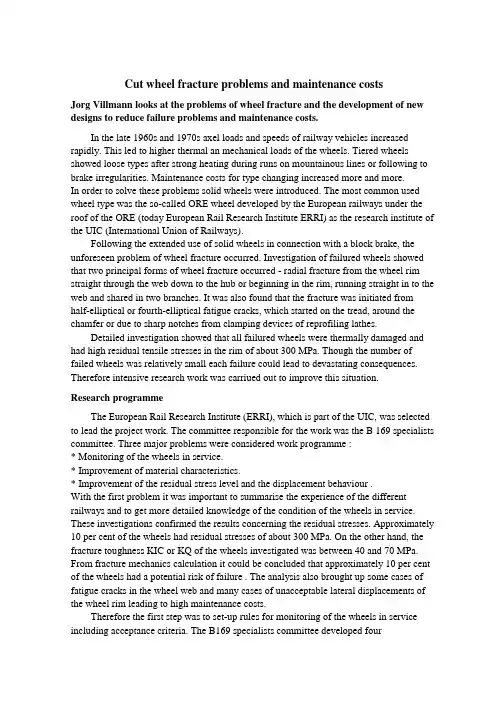
Cut wheel fracture problems and maintenance costsJorg Villmann looks at the problems of wheel fracture and the development of new designs to reduce failure problems and maintenance costs.In the late 1960s and 1970s axel loads and speeds of railway vehicles increased rapidly. This led to higher thermal an mechanical loads of the wheels. Tiered wheels showed loose types after strong heating during runs on mountainous lines or following to brake irregularities. Maintenance costs for type changing increased more and more.In order to solve these problems solid wheels were introduced. The most common used wheel type was the so-called ORE wheel developed by the European railways under the roof of the ORE (today European Rail Research Institute ERRI) as the research institute of the UIC (International Union of Railways).Following the extended use of solid wheels in connection with a block brake, the unforeseen problem of wheel fracture occurred. Investigation of failured wheels showed that two principal forms of wheel fracture occurred - radial fracture from the wheel rim straight through the web down to the hub or beginning in the rim, running straight in to the web and shared in two branches. It was also found that the fracture was initiated fromhalf-elliptical or fourth-elliptical fatigue cracks, which started on the tread, around the chamfer or due to sharp notches from clamping devices of reprofiling lathes.Detailed investigation showed that all failured wheels were thermally damaged and had high residual tensile stresses in the rim of about 300 MPa. Though the number of failed wheels was relatively small each failure could lead to devastating consequences. Therefore intensive research work was carriued out to improve this situation.Research programmeThe European Rail Research Institute (ERRI), which is part of the UIC, was selected to lead the project work. The committee responsible for the work was the B 169 specialists committee. Three major problems were considered work programme :* Monitoring of the wheels in service.* Improvement of material characteristics.* Improvement of the residual stress level and the displacement behaviour .With the first problem it was important to summarise the experience of the different railways and to get more detailed knowledge of the condition of the wheels in service. These investigations confirmed the results concerning the residual stresses. Approximately 10 per cent of the wheels had residual stresses of about 300 MPa. On the other hand, the fracture toughness KIC or KQ of the wheels investigated was between 40 and 70 MPa. From fracture mechanics calculation it could be concluded that approximately 10 per cent of the wheels had a potential risk of failure . The analysis also brought up some cases of fatigue cracks in the wheel web and many cases of unacceptable lateral displacements of the wheel rim leading to high maintenance costs.Therefore the first step was to set-up rules for monitoring of the wheels in service including acceptance criteria. The B169 specialists committee developed fourcharacteristics for visual inspection to identify potential wheels thermally overloaded . Criteria for the assessment of the wheels undergoing maintenance were also defined. Wheels with thermal damages must undergo residual stress measuring and, if required, crack detection. The whole procedure is defined in 4. Following to the implementation of the in-service rules and the continuous monitoring an essential reduction of wheel fracture was reached in Europe.In order to be independent from detailed maintenance rules and in-service monitoring, research then focused on the improvement of the wheel material. The results can be summarized as follows5:* Normally no KIC values were found, that are KQ values.* KQ is suitable to describe the material characteristics,.* KQ between 70 and 85 MPa is achievable for steel grade R7T.The third step focused on the reduction of the residual tensile stress level in the rim and on the lateral displacement of the rim. In this regard the shape of the wheel web is essential. Therefore different proposals were developed by the wheel producers and were tested under the roof of the ERRI research programme . Generally it can be stated that a more flexible wheel web is suitable to reduce the residual tensile stresses in the rim. On the other hand it is also possible to hold the displacements in a small tolerance band.RequirementsAs a result of the research work, a number of new requirements for wheel material and wheel design were defined. These requirements led to new or revised international specifications. The material requirements are defined in UIC-leaflet 812-36 and recently in the European standard EN 132627. For R7T steel grade (or ER7T according to EN 13262) a fracture toughness KIC or KQ of 80 MPa (mean value) and 70 MPa (minimum value) is required. For ER6T the corresponding requirements are 100 MPa (mean value) and 80 MPa (minimum value) given in EN 13262.Regarding the wheel design requirements the UIC published the new UIC leaflet 510-58 which was prepared by the ERRI B 169 specialists committee. This document is also the basis for the development of a new Draft European standard prEN 13979-1 which is in preparation now. The new standards are built up as a specification giving more freedom to the designer. According to these specifications four aspects of a new wheel design have to be considered:* Geometrical aspect: to allow interchangeability.* Thermo mechanical aspect: to manage wheel deformation and to ensure that braking do not induce wheel failure.* Mechanical aspect: to ensure that no fatigue crack in the web will occur.* Acoustical aspect: to ensure that the solution is better or equal compared with a reference wheel.Concerning the interchangeability requirements in three ways are necessary depending on the customer1:* Functional requirements, e.g. wheel diameter, tread profile, asymmetry of the hub withregard to the rim.* Fitting requirements, for example, length of the hub, bore diameter.* Maintenance requirements, e.g. clamping conditions of the wheelset reprofiling lathes.The designer has full freedom regarding the design of the wheel web.For railway vehicles with block brakes the brake power has to be considered. Tests with freight trains running on long mountainous lines through the Alps received an average brake power level of 50kW for a wheel with 920mm diameter. For smaller wheels the brake power is on a corresponding lower level. Therefore wheels for freight wagons have to resist these brake loads.For vehicles with different brake systems, such as disc brakes, an assessment of the thermal behaviour is not necessary. For combined brake systems (block brake and others) modified loads shall be agreed between customer and supplier.The brake loads are reproduced on a brake test bench. In order to check the thermal behaviour the wheel is loaded with a number of brake cycles. For the assessment unified criteria are defined in UIC 510-5 and prEN 13979-1 respectively. For the level of residual tensile stresses in the rim the following criteria are valid: For a wheel with its nominal diameter a stress level of maximum 200MPa (mean value) and maximum 250MPa (for each cross section) is acceptable. For a wheel with its diameter near the wear limit a stress level of maximum 275 MPa (mean value) and maximum 300 MPa is acceptable. Regarding the lateral displacement the analysis of maintenance rules, of the service experience and of the dimension of crossings and points led to allowable values between -1 mm and +3 mm (during braking) and between -0.5 mm and +1mm (in cold condition).For the mechanical aspect8 determine a relative conventional procedure. First step is a stress calculation using the finite element method. Three conventional load cases are to be considered representing straight track full curves and points and crossings. Based on these loads the normal stresses for each node of the FE mesh is calculated. Comparing the stresses for the different load cases a stress range or a stress amplitude can be calculated. The stress of the most stressed node shall be compared with the decision criteria, which are ±180 MPa for wheels with fully machined web and ±145 MPa for wheels with unmachined web. In addition to the calculation fatigue tests can be required. This depends on the results of the calculation and on the validity of the conventional loads. Two methods for fatigue tests are possible, either a random fatigue test or a one-stage fatigue test8. For both methods the test loads are derived from measured loads during field tests.Concerning the acoustical aspect it is, of course, not a target that new developed wheels have higher sound radiation compared with existing designs. Therefore a sound level is described which is comparable with the former ORE standard wheels8. The sound level can be determined by a calculation. The acoustical requirements are informative only.Product development and verificationThe stress ranges for the various designs are calculated as follows:* Wheel 21.061.00 (BA 004)/21.061.10 (BA 304) ±240.9 MPa (25 t axle load),* Wheel 21.431.01 (BA 378) ±175.9 MPa,* Wheel 21.430.01 (BA 375) ±168.9 MPa,* Wheel 21.463.00 ±185.2 MPa (exceptional lateral forces for the calculation required).Therefore for the wheel designs 21.061.00 (BA 004)/21.061.10 (BA 304)and21.463.00 additional fatigue tests are necessary. The results of both fatigue tests and field tests showed sufficient mechanical characteristics.ConclusionDue to increased service loads especially increased thermal loads, Radsatzfabrik Isenburg GmbH developed a family of wheel designs for different applications. They meet the requirements of the new or revised specifications. Up to now no failure of these designs occurred. The residual stress level is lower compared with the former designs. Therefore the residual stress measurement during the maintenance can be cancelled. Due to the low lateral displacements no wheelset has to be replaced. The wheels meet the interchangeability requirements ensuring an easy change of wheels. The new designs help the customer to reduce maintenance costs. For the future modifications of Radsatzfabrik's designs are possible depending on specific customer requirements.车轮断裂问题及维修费用Jorg Villmann研究车轮断裂问题,开发新的设计,以降低故障维修费用问题。
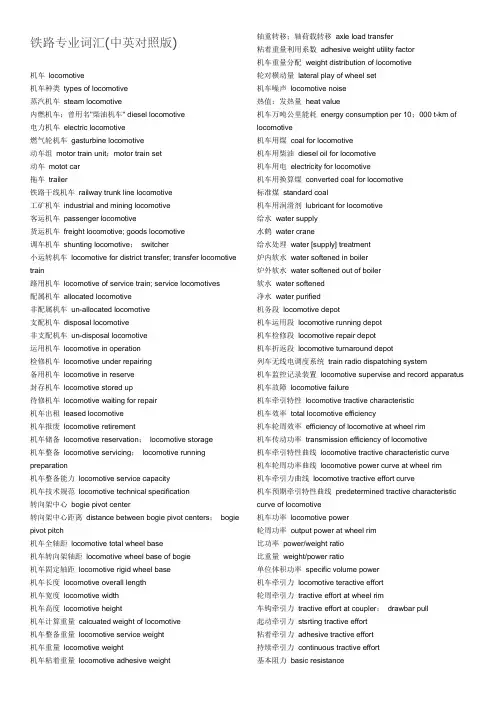
铁路专业词汇(中英对照版)机车locomotive机车种类types of locomotive蒸汽机车steam locomotive内燃机车;曾用名"柴油机车" diesel locomotive电力机车electric locomotive燃气轮机车gasturbine locomotive动车组motor train unit;motor train set动车motot car拖车trailer铁路干线机车railway trunk line locomotive工矿机车industrial and mining locomotive客运机车passenger locomotive货运机车freight locomotive; goods locomotive调车机车shunting locomotive;switcher小运转机车locomotive for district transfer; transfer locomotive train路用机车locomotive of service train; service locomotives配属机车allocated locomotive非配属机车un-allocated locomotive支配机车disposal locomotive非支配机车un-disposal locomotive运用机车locomotive in operation检修机车locomotive under repairing备用机车locomotive in reserve封存机车locomotive stored up待修机车locomotive waiting for repair机车出租leased locomotive机车报废locomotive retirement机车储备locomotive reservation;locomotive storage机车整备locomotive servicing;locomotive running preparation机车整备能力locomotive service capacity机车技术规范locomotive technical specification转向架中心bogie pivot center转向架中心距离distance between bogie pivot centers;bogie pivot pitch机车全轴距locomotive total wheel base机车转向架轴距locomotive wheel base of bogie机车固定轴距locomotive rigid wheel base机车长度locomotive overall length机车宽度locomotive width机车高度locomotive height机车计算重量calcuated weight of locomotive机车整备重量locomotive service weight机车重量locomotive weight机车粘着重量locomotive adhesive weight 轴重转移;轴荷载转移axle load transfer粘着重量利用系数adhesive weight utility factor机车重量分配weight distribution of locomotive轮对横动量lateral play of wheel set机车噪声locomotive noise热值;发热量heat value机车万吨公里能耗energy consumption per 10;000 t-km of locomotive机车用煤coal for locomotive机车用柴油diesel oil for locomotive机车用电electricity for locomotive机车用换算煤converted coal for locomotive标准煤standard coal机车用润滑剂lubricant for locomotive给水water supply水鹤water crane给水处理water [supply] treatment炉内软水water softened in boiler炉外软水water softened out of boiler软水water softened净水water purified机务段locomotive depot机车运用段locomotive running depot机车检修段locomotive repair depot机车折返段locomotive turnaround depot列车无线电调度系统train radio dispatching system机车监控记录装置locomotive supervise and record apparatus 机车故障locomotive failure机车牵引特性locomotive tractive characteristic机车效率total locomotive efficiency机车轮周效率efficiency of locomotive at wheel rim机车传动功率transmission efficiency of locomotive机车牵引特性曲线locomotive tractive characteristic curve机车轮周功率曲线locomotive power curve at wheel rim机车牵引力曲线locomotive tractive effort curve机车预期牵引特性曲线predetermined tractive characteristic curve of locomotive机车功率locomotive power轮周功率output power at wheel rim比功率power/weight ratio比重量weight/power ratio单位体积功率specific volume power机车牵引力locomotive teractive effort轮周牵引力tractive effort at wheel rim车钩牵引力tractive effort at coupler;drawbar pull起动牵引力stsrting tractive effort粘着牵引力adhesive tractive effort持续牵引力continuous tractive effort基本阻力basic resistance运行阻力running resistance惰行阻力idle runing resistance; coasting resistance起动阻力starting resistance附加阻力additional resistance坡道阻力gradient resistance曲线阻力curve resistance空气阻力air resistance单位阻力unit resistance; specific resistance换算阻力;加算阻力converted resistance速度控制系统speed control system加速acceleration减速deceleration恒速constant speed加速力acceleration force减速力deceleration force列车制动train braking制动方式brake mode空气制动air brake真空制动vacuum brake动力制动dynamic brake液力制动hydraulic brake电阻制动rheostatic brake再生制动regenerative brake电空制动electropneumatic brake蓄能制动energy—storing brake涡流制动eddy current brake磁轨制动electromagnetic rail brake踏面制动tread brake盘型制动disc brake机车制动周期locomotive braking period机车制动距离locomotive braking distance机车每轴闸瓦作用力brake shoe force per axle of locomotive 制动braking常用制动service braking;service application最大常用制动;常用全制动full servive braking;full service application阶段制动graduated application自然制动unintended braking; undesired braking紧急制动emergency braking;emergency application意外紧急制动undesirable emergency braking;UDE缓解release直接缓解;一次缓解direct release阶段缓解graduated release自然缓解unintended release;undesired release漏泄leakage充风;充气charging阶段提升graduated increasing保持位suppression; maintaining position;holding position 制动管减压量brake pipe pressure reduction 过量减压over reduction局部减压local reduction分段减压split reduction最大常用减压full servive reduction常用局减quick service紧急局减quick action前后风压差false gradient列车管压差train pipe pressure gradient保压停车stopping at maintaining position缓解停车stopping at release缓解波速release propagation rate制动波速braking propagation rate机车制动机locomotive brake gear空气压缩机air compressor调压器pressure regulator给风阀feed valve减压阀reducing valve机车分配阀locomotive distributing valve切换阀transfer valve自动制动阀automatic brake valve单独制动阀independent brake valve滤尘止回阀strainer check valve机车紧急放风阀locomotive emergency vent valve高压保安阀high pressure safety valve低压保安阀low pressure safety valve无载起动电空阀no—load starting electropneumatic valve 油水分离器oil—water separator总风缸main air reservoir空气干燥器air dryer撒砂装置sanding device砂箱sand box撒砂阀sanding valve撒砂器sandingsprayer紧急撒砂emergency sanding自动撒砂automatic sanding间隙效应slack actionL/V比值L/V ratio弓网关系pantograph—contact line relation机车牵引区段locomotive tractive district机车交路locomotive routing单肩回交路single-arm routing双肩回交路double-arm routing半循环交路semi-loop routing循环交路loop routing环形交路circular routing短交路short routing长交路long routing直通交路through routing机车乘务制度locomotive crew working system机车包乘制system of assigning crew to designated locomotive 机车轮乘制locomotive crew pooling system机车随乘制locomotive caboose crew system机车乘务组locomotive crew司机driver副司机assisant driver指导司机driver instructor司炉fireman机车运用指标index of locomotive operation机车出入段作业preparation of locomotive for leaving and arriving at depot机车全周转complete turnround of locomotive机车在段停留时间detention time of locomotive at depot机车全周转距离diatance of one complete turnround of locomotive机车全周转时间period of one complete turnround of locomotive机车走行公里locomotive running kilometers换算走行公里converted running kilometers沿线走行公里running kilometers on the road辅助走行公里auxiliary running kilometers本务走行公里leading locomotive running kilometers单机走行公里light locomotive running kilometers重联机车走行公里multi—locomotive running kilometers机车日车公里average daily locomotive running kilometers机车平均牵引总重average gross weight hauled by locomotive 机车日产量average daily output of locomotive运用机车台数number of locomotive in service机车需要系数coefficient of locomotives requirment单机运行light locomotive running双机牵引;双机重联牵引double locomotive traction多机牵引multi-locomotive traction主机;本务机车leading locomotive机车超重牵引traction for train exceed mass norm机车调度命令locomotive diapatching order机务段运行揭示running service—bulletin of depot司机运转保单driver’s service—report;driver's log司机室driver's cab司机操纵台driver’s desk司机模拟操纵装置simulator for driver train—handling优化操纵optimum handling; optimum optimum operation机车自动操纵automatic locomotive operation机车保养locomotive maintenance机车检修locomotive inspection and repair机车检修修程classification of locomotive repair机车大修locomotive overhaul [repair]; locomotive general overhaul架修intermediate repair定修periodical repair;light repair 蒸汽机车洗修steam locomotive boiler washout repair机车厂修locomotive repair in works机车段修locomotive repair in depot日常检查routine inspection机车临修locomotive temporary repair定期检修repair based on time or running kilometers状态检修repair based on condition of component换件大修component exchange repair配件互换修repair with interchangeable component预防维修制preventive maintenance system检修周期period of inspection and repair月检monthly inspection定检公里running kilometers between predetermined repairs 定检时间time between predetermined repairs检修范围scope of repairing course; scope of repair超范围修理repair beyond the scope of repairing course检修停时standing time under repair集中化修理;集中修centralization of repair检修基本技术条件fundamental technical requirements for repair and inspection检修工艺规程technological regulations for repair and inspection检修作业程序repair procedure; shop program磨耗限度limit of wear检修限度locomotive repair limit第一限度1st limit第二限度2nd limit使用限度operation limit中间工艺检验intermediate inspection at the technological process转向设备turning facilities转盘turntable机务设备通过能力carrying capacity of locomotive facilities 机车专用设备special equipment for locomotive operation机车验收acceptance of locomotive机车试运转locomotive trial run形式试验type test性能试验performance test鉴定试验homologation test出厂试验predelivery test制动试验brake test牵引试验traction test负载试验loaded test; load test牵引热工试验traction and thermodynamique de traction定置试验stationary test;test at standstill动力学试验dynamics test强度试验strength test运用试验service test;operation test耐久性试验durability test可靠性试验reliability test例行试验routine test特殊试验special test研究性试验investigation test抽样试验sampling test模拟试验analogue test机车履历簿locomotive logbook直流电力机车DC electric locomotive单向交流电力机车single-phase AC electric locomotive单相工频交流电力机车single-phase industrial frequency AC electric locomotive双电压制电力机车dual voltage electric locomotive双频率制电力机车dual frequency electric locomotive多电流制电力机车multiple system electric locomotive硅整流器电力机车silicon rectifier electric locomotive晶闸管整流器电力机车thyristor rectifier electric locomotive经闸管变流器电力机车thyristor converter electric locomotive 电动车组electric multiple unit; motor coach set;electric motor train unit单相交流电动车组single-phase industrial frequency AC motor train unit地下铁道电动车组subway motor train unit电流制current system直流制DC system单相工频交流制single—phase industrial frequency AC system 单相低频交流制single—phase low frequency AC system受电弓标称电压nominal voltage at pantograph调压方式voltage regulation mode高压侧调压high voltage regulation低压侧调压low voltage regulation分级调压stepped voltage regulation无级调压stepless voltage regulation相控调压phase control斩波调压chopper control变阻调压rheostatric control整流方式mode of rectification牵引变流器traction convertor牵引逆变器traction invertor牵引变频器traction frequency convertor可调牵引变频器variable frequency convertor直流斩波器DC chopper单相桥式整流器single—phase bridge rectifier三相桥式整流器three—phase bridge rectifier可控桥式整流器controlled bridge rectifier对称半控桥式整流器symmetric half-controlled bridge rectifier 非对称半控桥式整流器asymmetric half-controlled bridge rectifier多段桥[联结] bridges in cascade;multi rectifier bridge硅整流装置silicon rectifier device 晶闸管整流装置thyristor rectifier device励磁整流装置excitation rectifier device电力传动方式mode of electric drive直流传动DC drive交-直流传动AC-DC drive交-直-交流传动AC—DC—AC drive调速方式mode of speed control变压调速variable voltage speed control变频调速variable frequency speed control变极调速pole changing speed control车轴驱动方式mode of axle drive弹性齿轮驱动resilient gear drive刚性齿轮驱动solid gear drive单侧减速齿轮驱动single reduction gear drive双侧减速齿轮驱动double reduction gear drive单电动机驱动monomotor drive车轴空心轴驱动quill drive; hollow axle drive电机空心轴驱动hollow shaft motor drive万向轴驱动cardan shaft drive直接驱动gearless drive;direct drive独立驱动individual drive组合驱动coupled axle drive连杆驱动rod drive组合传动机车coupled axle drive locomotive独立传动机车individual drive locomotive齿轨[传动]机车;齿条传动机车rack locomotive牵引电动机供电制式traction motor power supply system 机车集中供电locomotive centralized power supply转向架独立供电bogie individual power supply电动机独立供电motor individual power supply主电路power circuit;main circuit高压电路high voltage circuit; high tension circuit低压电路low voltage circuit;low tension circuit网侧电路circuit on side of overhead contact line牵引电路traction circuit制动电路braking circuit滤波电路filter circuit辅助电路auxiliary circuit列车供电电路power supply circuit for train控制电路control circuit控制电源control source蓄电池电路battery circuit指令电路command circuit照明电路lighting circuit仪表电路instrument circuit联锁电路interlocking circuit信号电路signal circuit起动电路starting circuit保护电路protective circuit电子控制电路electronic control circuit电空制动电路electropneumatic brake ciucuit;E—P brake circuit防空转防滑行保护电路anti—slip/slide protection circuit音频通讯电路audio communication circuit电连接器electric coupler自动电连接器electric automatic coupler机车重联电连接器multi—locomotive electrc coupler牵引电动机traction motor直流牵引电动机DC traction motor脉流牵引电动机pulsating current traction motor交流牵引电动机AC traction motor单向交流牵引电动机single-phase AC traction motor三相交流牵引电动机three phase AC traction motor抱轴式牵引电动机axle hung traction motor;nose suspension traction motor架承式牵引电动机frame mounted traction motor转向架架承式牵引电动机bogie mounted traction motor底架架承式牵引电动机underframe mounted traction motor串励电动机series excited motor并励电动机shunt excited motor复励电动机compound excied motor他励电动机separately excited motor同步电动机synchronous motor异步电动机asynchronous motor交流换向器电动机alternating current commutator motor全封闭式电动机totally-enclosed motor通风式电动机ventilated motor自通风式电动机self-ventilated motor强迫通风式电动机force ventilated motor直线电动机;线性电动机linear motor直线同步电动机linear synchronous motor直线异步电动机;直线感应电动机linear asynchronous motor;linear induction motor电动机转速motor speed电动机超速runaway speed电动机特性motor characteristic电动机转矩;电动机扭矩motor torque启动转矩starting torque峰值转矩peak torque制动转矩braking torque最大输出功率maximum output启动电流starting current峰值电流peak current标称电压nominal voltage变压器电势transformer EMF片间平均电压mean voltage between segments片间最高电压maximum voltage between segments消弱磁场weakened field 最大磁场maximum field最小磁场minimum field磁场消弱率field weakening磁场消弱系数coefficient of field weakening恒功调速比speed ratio on constant power转向器commutator换向片commutator segment电枢线圈armature coil均压线equalizer;cable bond转轴shaft定子stator转子rotor主极铁心mainpole core主极线圈mainpole coil换向极铁心interpole core换相极线圈interpole coil补偿线圈compensating coil机座frame铸造机座cast frame焊接机座welding frame半叠片机座semi—laminated frame全叠片机座full-laminated frame电刷装置brush gear刷握brush—holder刷盒brush box电刷brush端盖end shield抱轴悬挂装置suspension bearing主发电机main generator直流主发电机DC main generator交流主发电机main alternator辅助发电机auxiliary generator直流辅助发电机DC auxiliary generator直流启动发电机DC starting generator; dynastarter 直流控制发电机DC control generator直流励磁机DC exciter劈相机Arno converter;phase splitter辅助电动机auxiliary motor直流辅助电动机DC quxiliary motor异步辅助电动机asynchronous auxiliary motor空压机电动机air compressor motor通风机电动机blower motor泵电动机pump motor控制电机control electric machine自整角机synchro测速发电机tachogenerator机车牵引变压器traction transformer of locomotive 心式牵引变压器core-type traction transformer壳式牵引变压器shell-type traction transformer自藕牵引变压器traction autotransformer调压牵引变压器regulating traction transformer分接牵引变压器tapped traction transformer油浸式牵引变压器oil-immersed type traction transformer 整流变压器rectifier transformer电源变压器supply transformer隔离变压器;绝缘变压器isolating transformer同步变压器synchronous transformer脉冲变压器pulse transformer控制变压器control transformer信号变压器signal transformer励磁变压器excitation transformer高压绕组high voltage winding;high tension winding低压绕组low voltage winding; low tension winding调压绕组regulating winding励磁绕组excitation winding辅助绕组auxiliary winding列车供电绕组train coach supply winding自然循环natural circulation强迫循环forced circulation强迫导向循环forced guided circulation牵引电抗器traction tractor平波电抗器smoothing reactor过渡电抗器transition reactor接地电抗器earthing reactor; grounding reactor制动电抗器braking reactor分流电抗器divert shunt reactor;inductive shunt滤波电抗器filter reactor均流电抗器sharing reactor限流电抗器inductive reactor; current limiting reactor换相电抗器commutation reactor起动电阻器staring resistor制动电阻器braking resistor过渡电阻器transistion resistor分流电阻器divert shunt resistor; shunting resistor稳定电阻器stabilizing resistor调节电阻器regulating resistor制动电阻柜braking resistor cubicle制动电阻元件braking resistor grid非线性电阻器non—linear resistor滤波电容器filter capacitor换相电容器commutating capacitor保护电容器protective capacitor起动电容器starting capacitor补偿电容器compensation capacitor主断路器line circuit—breaker真空主断路器line vacuum circuit-breaker空气主断路器line air-blast circuit—breaker直流高速断路器DC high speed circuit-breaker 受电器current collector受电弓pantograph单臂受电弓single arm pantograph双臂受电弓double arm pantograph弓头pantograph bow受电弓滑板pantograph pan弓角pantograph horn受电弓气缸pantograph cylinder支持绝缘子supporting insulator第三轨受电器conductor rail collector受电靴装置shoegear集电靴collector shoe电磁接触器electromagnetic contactor直流接触器DC contactor交流接触器AC contactor电空接触器electropneumatic contactor组合接触器grouping contactor线路接触器line contactor磁场削弱接触器field weakening contactor制动接触器braking contactor励磁接触器excitation contactor辅助接触器auxiliary contactor调压开关tap changer低压调压开关low voltage tap changer; low tension tap changer高压调压开关high voltage tap changer;high tension tap changer位置转换开关position changeover switch鼓形位置转换开关drum position changeover switch凸轮位置转换开关cam position changeover switch牵引-制动位转换开关power/brake changeover switch反向器reverser电流制转换开关current system changeover switch主电路库用转换开关main circuit transfer switch for shed supply辅助电路库用转换开关auxiliary circuit transfer switch for shed supply短路器short-circuiting device接地开关earthing switch牵引电动机隔离开关traction motor isolating switch受电弓隔离开关pantograph isolating switch主整流柜隔离开关isolating switch for main silicon rectifier cubicle劈相机故障隔离开关fault isolating switch for phase splitter控制电源隔离开关isolating switch for control supply司机控制器driver controller调车控制器shunting controller电空制动控制器E—P brake controller按键开关button switch; key switch自复式按键开关self-reset push-key switch非自复式按键开关non-self-reset push-key switch主按键开关组main button switch group;main key switch set 副按键开关组secondary push—key switch group;secondary key switch set电磁阀electromagnetic valve电空阀clectropneumatic valve电液阀electro—hydraulic valve保护阀protective valve受电弓电空阀pantograph valve防空转撒沙电空阀anti—slip sanding valve防空转防滑行保护装置anti—slip/slide protection device轴重转移补偿装置axle load transfer compensation device功率因数补偿装置power factor compensation device电压继电器voltage relay电流继电器current relay时间继电器time relay中间继电器intermediate relay速度继电器speed relay温度继电器temperature relay压力继电器pressure relay欠电压继电器under—voltage relay过电流继电器over—current relay转速继电器tachometric relay流速继电器flow relay接地继电器earth fault relay风压继电器air pressure relay油压继电器oil-pressure relay起动继电器starting relay主电路库用插座main circuit socket for shed supply辅助电路库用插座auxiliary circuit socket for shed supply控制电路库用插座control circuit socket for shed supply重联插座multiple unit socket印制电路板插座printed circuit board socket电压调整器voltage regulator温度调整器temperature regulator位置指示器notch indicator数字显示器digital display司机室取暖电炉driver’s cab electric heater司机室热风装置driver’s cab air heater司机室空调装置driver’s cab air conditioner电热玻璃electric heating glass电测仪表electrical measuring instrument牵引电机电压表traction motor voltmeter牵引电机电流表traction motor ammeter励磁电流表excitation ammeter网侧电压表voltmeter on side of overhead contact line;overhead side voltmeter辅助电路电压表auxiliary circuit voltmeter 控制电源电压表control supply voltmeter控制电源电流表control supply ammeter机车速度表locomotive speedometer单相电度表single-phase wat-hour meter速度记录仪tachograph传感器sensor;transducer电压传感器voltage sensor电流传感器current sensor压力传感器pressure sensor速度传感器speed sensor温度传感器temperature sensor直流电流互感器DC current transformer阀形避雷器valve type arrester放电器discharger轮缘喷油器flange lubricator接地安全棒earthing pole接地回流电刷earth return brush前照灯head lamp; head light副前照灯subhead lamp;dim head light标志灯marker lamp走行部灯bogie lamp车号灯side number plate lamp路签灯train staff lamp记事灯writing lamp照明灯illuminating lamp指示灯indicator lamp风喇叭air horn高音风喇叭high tone air horn低音风喇叭low tone air horn警笛siren警惕装置vigilance device机车组装后的检查与试验inspection and test of locomotive after completion of construction一般性检查general inspection称重试验weighing test压缩空气设备全面的气密性试验test for over-all air-tightness of compressed air equipments车体及外部装备密封试验test for sealing of body and external equipment受电弓试验pantograph test介电强度试验dielectric test事故预防措施的检查checks for prevention of accidents安全设备试验test on safety equipments蓄电池充电系统试验checks of battery charging—arrangement 通风冷却试验test on ventilation and cooling空气制动试验test on air brake曲线通过实验curve negotiation test机车振动参数测试measurements of vibration parameters辅助机组试验test on auxiliary machines机车调速试验test on speed regulation主电路短路保护系统试验test on short-circuit protection system of main circuit主电路过载保护系统试验test on overload protection system of main circuit内部过电压试验test on internal overvoltage外部过电试验test on external overvoltage机车功率试验locomotive [traction] power test机车功率因数测定measurment of power factor机车效率测定measurement of efficiency of locomotive谐波电流百分比测定measurement of percentage of harmonic current起动加速试验starting and acceleration test运行阻力试验test for running resistance电气制动试验electric braking test滤尘效果试验test on filter efficiency撒沙装置试验test on sanding gear重联运行试验test on coupled operation;test on multi unit operation司机室工作条件检查check on working conditions in the driver’s cab4。

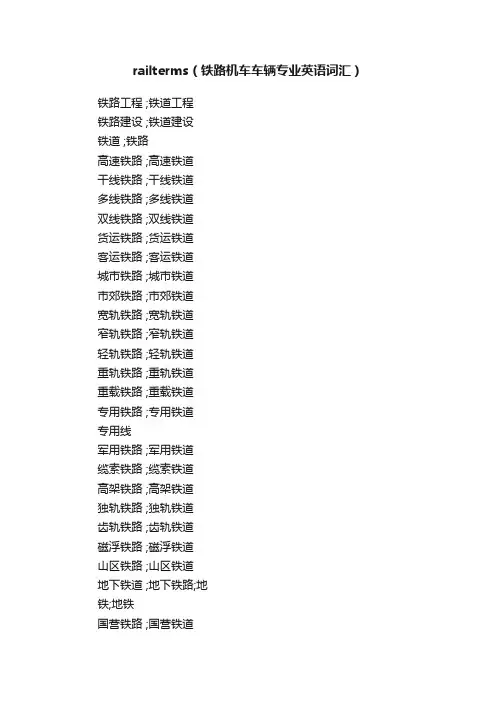
railterms(铁路机车车辆专业英语词汇)铁路工程 ;铁道工程铁路建设 ;铁道建设铁道 ;铁路高速铁路 ;高速铁道干线铁路 ;干线铁道多线铁路 ;多线铁道双线铁路 ;双线铁道货运铁路 ;货运铁道客运铁路 ;客运铁道城市铁路 ;城市铁道市郊铁路 ;市郊铁道宽轨铁路 ;宽轨铁道窄轨铁路 ;窄轨铁道轻轨铁路 ;轻轨铁道重轨铁路 ;重轨铁道重载铁路 ;重载铁道专用铁路 ;专用铁道专用线军用铁路 ;军用铁道缆索铁路 ;缆索铁道高架铁路 ;高架铁道独轨铁路 ;独轨铁道齿轨铁路 ;齿轨铁道磁浮铁路 ;磁浮铁道山区铁路 ;山区铁道地下铁道 ;地下铁路;地铁;地铁国营铁路 ;国营铁道私营铁路 ;私营铁道合资铁路 ;合资铁道地方铁路 ;地方铁道联邦铁路 ;联邦铁道既有铁路 ;既有铁道;既有线新建铁路 ;新建铁道试验线 ;实验线环行试验线 ;环行实验线新线建设铁路规划 ;铁道规划路网规划铁路用地 ;铁道用地铁路用电 ;铁道用电铁路用水 ;铁道用水新线验收新线运营旧线改造线路改造桥梁改建隧道改建电气化铁道改造 ;电气化铁路改造复线修建旧线改造投资工程经济铁路投资 ;铁道投资新线投资基建投资铁路电气化投资 ;铁道电气化投资投资预算预算决算造价贷款集资 ;融资经济核算招标投标承包U形桥台安全标志安全地点安全电压安全技术措施安全距离安全帽安全绳安全梯安全网安全用电安全炸药安全装置暗挖法拔起高度板式橡胶支座半穿式桥半堤半堑半路堑式明洞半湿喷混凝土机半压力式涵洞保护地线保险带爆破排淤崩塌地段路基避车台边沟变更设计变坡点标准贯入试验滨河路堤不良地质步行板槽式列车槽型梁侧壁导坑法测段测量放样测量精度插板支护插入式混凝土振捣器拆迁拆装式桁架柴排柴油打桩机颤振长大坡道长线张拉台座超前导坑超前锚杆潮喷混凝土车站隧道沉管法沉井挡墙沉井刃脚承台驰振冲击式钻机冲击系数抽验出碴初步设计初测初期支护触电保安器船只或排筏的撞击力粗粒土填料大桥大型矿车大型临时工程带式输送机待避所单侧导坑法单斗挖土机单梁式架桥机单曲线单位工程单线桥单线隧道单项预算单转子滑片式空压机导流建筑物导线测量导向线倒虹吸管道碴桥面低高度梁地层压力地层柱状图地貌调查地温梯度地形调查地震基本烈度地震力地震系数法地震震级地质图测绘电动吊车电动卷扬机吊沟吊缆调查测绘调查坑道调整总概算丁坝顶推式架设法定测动力触探试验动力坡度冻结深度冻胀力洞口洞口段衬砌洞门洞室药包爆破洞穴地段路基斗车斗式提升机端横梁端墙式洞门短隧道断高断链墩身多年冻土路基多线隧道耳墙式洞门二次衬砌反铲挖土机反滤层反台阶法反向曲线反压护道方案比选防爆设施防尘防风栅栏防护拦杆防护音响信号防滑鞋防火净距防火门防雷装置防水等级防水涂层防坠器放线非紧坡地段非渗水土路基废弃工程分部工程分部开挖法分坡平段分水岭分项工程分转向角风道式通风风动凿岩机风镐风管式通风风荷载风沙地段路基风嘴浮力浮式沉井基础浮式起重机浮箱浮运架桥法辅助设施附加力附着式混凝土振捣器复曲线副交点覆盖防护盖板涵盖板式棚洞概率极限状态设计法概算定额干喷混凝土干喷混凝土机刚架式棚洞钢拱支撑钢筋调直机钢筋混凝土桩钢筋冷拉机钢筋切断机钢筋弯曲机钢桩格构拱蛤壳式抓斗隔断层隔火带个别概算工程报价工程承包工程船舶工程地质图工程地质选线工程发包工程间接费工程投标工程预备费工程运输工程招标工程直接费工程质量检验工程质量评定工程质量验收工法制度公铁两用桥拱背线拱度拱腹拱腹线拱肋拱圈封顶拱矢拱形明洞构件支撑构造钢筋估算指标箍筋鼓筒式混凝土搅拌机固端拱关键工程管柱挡墙灌浆压力灌筑水下混凝土光电导线滚轴支座过渡工程涵洞孔径旱桥航测外控点航测选线航带设计合格工程河床铺砌河道调查河流比降河滩路堤核子密度湿度测定恒载横洞横断面选线横联横通道衡重式挡土墙洪水调查洪水频率后张法预应力梁护道护墙护筒滑坡地段路基缓和曲线半径变更率缓坡地段换侧换算均布活载换土灰土换填夯实法汇水区流域特征调查混凝土泵车混凝土吊斗混凝土搅拌楼混凝土搅拌运输车混凝土桥混凝土振动台活动吊篮活动模架逐跨施工法活动桥机械台班定额基床基床底层基底极限状态设计法急流槽挤密砂桩技术设计加固地基加筋土挡土墙加力牵引坡度加速缓坡加桩夹直线架立钢筋架桥机架设法检查井简易混凝土搅拌站建筑业总产值交点交接桩接触网作业车节点板节间节间长度截水沟紧坡地段近体防护浸水路堤经纬距精密导线测量净跨静水压力静压力拔桩机救生设施就地灌注桩就地灌筑法矩形桥墩聚四氟乙烯支座绝缘鞋掘进机法均方[误]差均衡坡度竣工报告竣工决算喀斯特地段路基开工报告开挖工作面勘探抗滑明洞抗剪连接件可行性研究坑道自稳时间空腹拱空气幕沉井法空心板桥空中索道控制工程控制区间跨径矿山法扩大扩大初步设计扩大基础拉槽拦石墙栏杆缆索起重机朗格尔式桥离心水泵历史洪水位立爪式装岩机梁端缓冲梁梁高梁腋两阶段设计列车冲击力列车横向摇摆力列车活塞作用列车活载列车离心力列车牵引力列车制动力临界高度临界坡度临时工程临时性桥临时支护流冰流砂流水压力漏斗棚架法路堤边坡路堤填料路拱路基承载板测定路基横断面路基面路基面宽度路肩高程路堑边坡路堑平台路堑石方爆破路堑式明洞履带式起重机履带式桩架轮渡引线轮渡栈桥轮渡站轮胎式起重机螺杆式空气压缩机螺栓示功扳手螺旋喷射桩裸露药包爆破洛泽式桥落石槽落石冲击力马口埋置式桥台盲沟锚定板挡土墙锚定板式桥台锚碇锚杆挡墙锚跨锚座铆接钢桥冒顶明洞门明桥面明渠模筑衬砌摩擦结合式高强度螺栓蘑菇形开挖法木桩目测尼尔森式洛泽梁桥尼尔森体系桥泥浆套沉井法泥石流地段路基泥石流流域泥沼地区路基扭剪式高强度螺栓爬升模板排架排架式桥墩排水砂垫层抛石挤淤抛掷爆破喷锚构筑法喷锚支护喷射钢纤维混凝土喷射混凝土回弹喷射混凝土机械手盆式橡胶支座棚洞膨胀土地区路基偏压衬砌拼接板品字形导坑法平板式混凝土振捣器平孔排水平行导坑平旋桥平原地区选线坡度代数差坡段坡段长度坡脚坡面防护破冰体破损阶段设计法起动缓坡起拱点起重横梁气象资料弃土堆汽车式起重机前墙潜孔钻机潜水泵潜水钻机浅孔爆破堑顶强制式混凝土搅拌机墙顶封口桥渡勘测设计桥涵拱圈桥涵水文桥梁标准活载桥梁道碴槽桥梁合龙桥梁荷载谱桥梁护轨桥梁护木桥梁全长桥梁上部结构桥梁下部结构桥梁自振周期桥前壅水高度桥上人行道桥下净空桥轴线测量丘陵地段选线球面支座区域地质曲线控制点曲线折减取土坑取样试验检查全断面开挖法全焊钢桥全回转式架梁起重机全球定位系统全验缺陷工程扰流板绕行地段人行道荷载人员掩蔽所人字坡容许冲刷容许应力设计法软土地区路基三角测量三角高程测量三铰拱三阶段设计砂井砂土液化山区河谷选线上导坑法上下导坑法设计概算设计高程设计荷载设计洪水过程线设计鉴定设计阶段设计流量设计流速设计水位深井水泵渗井渗水暗沟渗水隧洞渗水土路基施工产值施工调查施工防护施工复测施工工艺流程施工荷载施工机械利用率施工机械完好率施工计划管理施工利润施工水位施工图设计施工形象进度施工验收施工准备施工总工期施工组织方案湿喷混凝土湿喷混凝土机湿式凿岩石灰砂桩实腹拱实施性施工组织设计实体桥墩事故报告试桩室内测试手持式凿岩机。

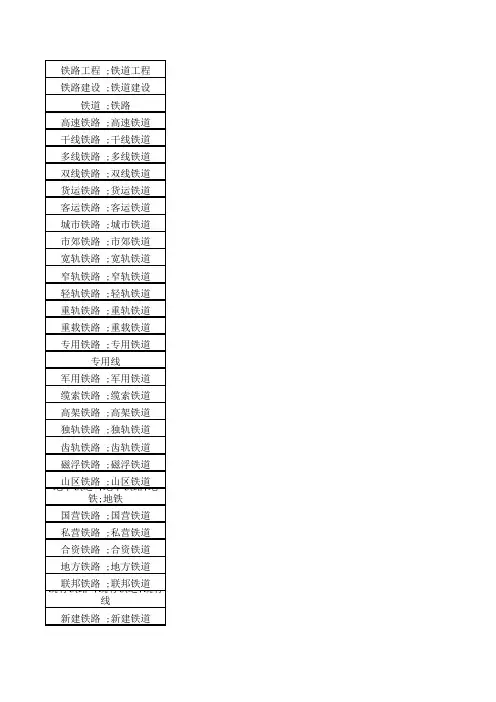
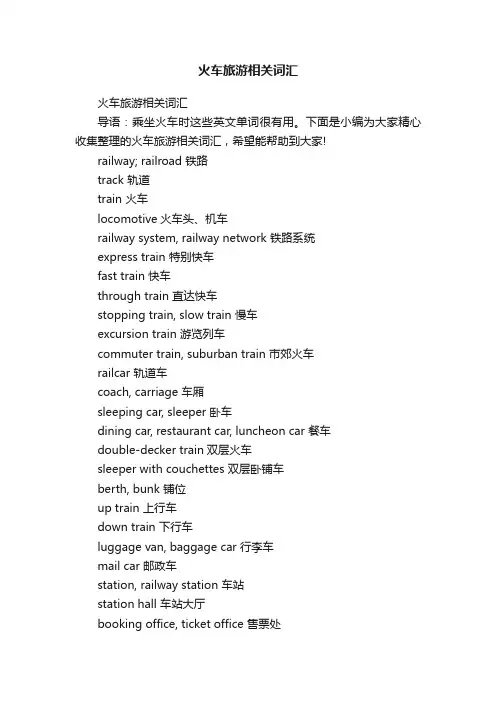
火车旅游相关词汇火车旅游相关词汇导语:乘坐火车时这些英文单词很有用。
下面是小编为大家精心收集整理的火车旅游相关词汇,希望能帮助到大家!railway; railroad 铁路track 轨道train 火车locomotive火车头、机车railway system, railway network 铁路系统express train 特别快车fast train 快车through train 直达快车stopping train, slow train 慢车excursion train 游览列车commuter train, suburban train 市郊火车railcar 轨道车coach, carriage 车厢sleeping car, sleeper 卧车dining car, restaurant car, luncheon car 餐车double-decker train双层火车sleeper with couchettes 双层卧铺车berth, bunk 铺位up train 上行车down train 下行车luggage van, baggage car 行李车mail car 邮政车station, railway station 车站station hall 车站大厅booking office, ticket office 售票处ticket-collector, gateman 收票员ticket inspector 验票员platform 月台, 站台platform ticket 站台票terminal终点站railway policeman乘警buffet 小卖部waiting room 候车室mother-and-child room母子候车室VIP room贵宾候车室platform bridge 天桥。
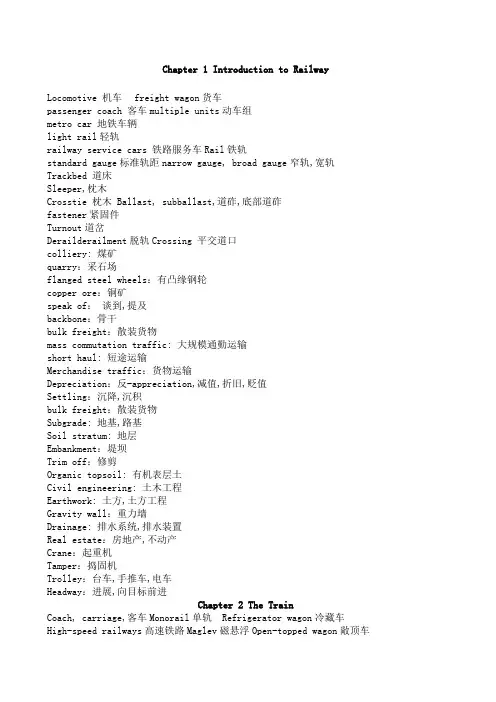
Chapter 1 Introduction to RailwayLocomotive 机车freight wagon货车passenger coach 客车multiple units动车组metro car 地铁车辆light rail轻轨railway service cars 铁路服务车Rail铁轨standard gauge标准轨距narrow gauge, broad gauge窄轨,宽轨Trackbed 道床Sleeper,枕木Crosstie 枕木 Ballast, subballast,道砟,底部道砟fastener紧固件Turnout道岔Derailderailment脱轨Crossing 平交道口colliery: 煤矿quarry:采石场flanged steel wheels:有凸缘钢轮copper ore:铜矿speak of:谈到,提及backbone:骨干bulk freight:散装货物mass commutation traffic: 大规模通勤运输short haul: 短途运输Merchandise traffic:货物运输Depreciation:反-appreciation,减值,折旧,贬值Settling:沉降,沉积bulk freight:散装货物Subgrade: 地基,路基Soil stratum: 地层Embankment:堤坝Trim off:修剪Organic topsoil: 有机表层土Civil engineering: 土木工程Earthwork: 土方,土方工程Gravity wall:重力墙Drainage: 排水系统,排水装置Real estate:房地产,不动产Crane:起重机Tamper:捣固机Trolley:台车,手推车,电车Headway:进展,向目标前进Chapter 2 The TrainCoach, carriage,客车Monorail单轨Refrigerator wagon冷藏车High-speed railways高速铁路Maglev磁悬浮Open-topped wagon敞顶车Cog railway嵌齿铁路Rubber-tired underground橡胶轮地铁Siding旁轨,支线Freight train货运列车Passenger train旅客列车Heavy freight重载货运Sleeping car卧铺车Dining car餐车Run-around track调车线Inter-city train城际列车Local train管内列车,慢车Elctric traction电力牵引Stopper慢车Double-decked passenger train双层旅客列车Motor car trailer car动力车拖车Container集装箱车Tanker罐车Driving cab司机室TOFC平板拖车Box wagon棚车Coupler车钩Maintenance of way 道路维护 Long-distance train长途列车Channel Tunnel海峡隧道parcel: package 包裹Travelling post offices:移动邮局Centrifugal force:离心力pram:婴儿车Wheelchair:轮椅Conurbation:有卫星城市的大都市elevated structure :高架结构Accelerate decelerate: 加速减速Tram, trolley, streetcar:有轨电车Flexibility:机动,灵活Low loder:低架拖车Sneak into:偷偷地摸进Stow away:偷乘,搭白车Fatality:disasterKit:工具包,装备earn one‘s keep:值得雇用, 挣饭吃Show up:揭露,露出Dead end terminal:闭塞终端Buffer stop:止冲器Crossover:转辙轨Locomotive escape:机车折返Phase out:逐步淘汰,逐步停止Intensive service:auxiliary equipment:辅助设备, 备用设备, 附属设备Heavy maintenance:大修Whilst:时时,同时,whilePush-pull:推挽Interval service:Keep at forefront of:保持在……最前沿train loading:列车运载量Train capacity:列车运载能力Density of passengers:乘客密度Load factor:上座率Patronage:保护,光顾,赞助High degree of standardisation:高度标准化Headstock, end sill, pilot:end beamBellmouth:钟形口,喇叭口Line up:整队,排列Semipermanent coupler:半永久车钩Be bolted together:螺栓连接Cushioning:减震,缓冲Uncoupling:解钩,拆开反,couplingBuckeye, Knuckle and Janney coupler: 詹式车钩Coupler knuckle jaw:钩舌Coupler head:钩头Hinge pin:折页销Fully automatic coupler:全自动车钩Disengage:脱离pneumatical:风力的,空气的Keep in good working order:保持正常运转状态Drawgear:牵引装置Bolt:螺栓Pedal:踏板Funicular: 索道Coupler alignment bar:车钩调直杆Pushbutton:按钮Shock absorber:减震器Multicore cable:多芯电缆Chapter 7 Railway Cars1Baggage行列车Coach客车 Combine合造车Dome圆顶车Lounge游乐车Dinner餐车Observation了望车Sleeper, sleeping car, Pullman卧铺车RPO铁路邮政车Housing car封闭车Autorack, auto carrier汽车运输车Boxcar, or van棚车Refrigerator car, reefer冷藏车 Stock car牲畜车Open top car敞车Gondola敞车Hopper漏斗车Ballast car砟车Flat car平车Depressed-center flat car凹底平车Piggyback car背负式车Schnabel car钳夹车Tank car罐车Caboose守车Snow plow除雪犁Dynamometer car动力检测试验车Encompasss: 包围,环绕,构成,包括Listed in alphabetic order: 按字母顺序排列lining:衬里,衬套,内层,lined withContamination:污染,玷污Corrosive action:腐蚀作用Stainless steel:不锈钢Glass enamel:玻璃釉彩,搪瓷Pocket for stake: 柱插口Tie-down point:栓柱Manual brake equipment: 手制动Air brake equipment: 空气制动primary underframe: 主车架,主底架Cumbersome : 笨重的Intermodal shipping: 联合运输Tonnage:吨位log:木材,原木Lumber:木材Slope down:向下斜Scrap metal: 金属屑,废金属Aggregate:粒料,总计,聚集Wood chip:木屑,木片Drop end:落端门Shovel:铲Perishable freight:易腐货物spoiling: 变坏,损毁Insulation:绝缘层,保温层Keep out:Cooling system:冷却系统Cold brine:冷盐水Waterproof:防水的Airtight:密封的,气密的Warehouse:仓库,库房Breakage:破坏,破损Barrel:桶Drum:鼓型圆桶safety valve:安全阀Chapter 8 Railway Cars2For more information seetrain摆式列车Head-end equipment车端设备Branch line支线Air-conditioned hard seat car空调硬座车seating capacity定员Length between truck pivot centers车辆定距tare weight空重Clearance 间隙Wheelbase轴距Gauge轨距 Constructional speed构造速度Wheel diameter车轮直径Stanhope:轻便马车en route:在途中Streamlined:流线型的Ornate:装饰的, 华丽的, 文体绚丽的to date:到此为止Aluminum steel:铝钢,含铝钢evolve into:发展进化成Fluted:有凹槽的Conveyance:运输Row upon row:一排排,一行行carry-on:手提行李,手提的Aisle:走廊Partitioned into:分割,分隔开efficiency apartment:有小厨房和卫生设备的小套公寓房间,公寓小套间Interior:内部Galley:厨房Recede:后退,倒退,变得模糊Fell out of use: 开始不用,渐废Vantage:优势,有利情况Roofline:屋顶轮廓线Dumbwaiter:楼上楼下送饭菜的小升降机,可移动的上菜架或上菜桌Aluminum of high strength alloy:高强度铝合金pane:长方块, 尤指窗格, 窗格玻璃, 边, 面,方框Vestibule:门廊, 前厅Chapter 9 BogieRide comfort乘坐舒适性Irregularity轨道不平顺Wheel tread车轮踏面Suspension悬挂系统Tread gradient踏面锥度Flange轮缘Running performance运行品质Articulated bogies铰接式转向架 Lower center of gravity低重心Swing hanger摇枕吊Bolster bogie摇枕转向架Bolsterless bogie无摇枕转向架Wheelset hunting轮对蛇行Anti-yaw damper抗蛇行减震器Suspension gear悬挂装置JR日本铁路Bogie frame构架Lateral damper横向减震器Traction transfer device牵引装置Brake equipment制动装置 Axle bearing and axle box轴箱轴承及轴箱Axle spring轴箱弹簧Brake disk制动盘Traction motor牵引电机Gear box齿轮箱,减速箱Wheelset轮对Traction force牵引力Air spring, air bag空气弹簧Side beam侧梁Coil spring圆弹簧Cross beam横梁Press welding压力焊Bearing轴承Support rigidity支撑刚度Pedestal swing spring type导框式定位Play,游间,游隙,摆动量Leaf spring板弹簧IS typeIS拉板式定位Bending strength弯曲强度Unsprung massweightNon-sprung mass簧下质量 Axle beam type转臂式定位Cylindrical roller bearing圆柱滚子轴承Ball bearing球轴承Overhaul大修Nose suspension device轴悬,臂式悬挂装置Cardan driving device 万向轴驱动Torque converter变扭器Wheel tread brake踏面制动Disc brake盘型制动Brake shoe闸瓦Frictional heat摩擦热Brake pad制动闸片Motor braking动力制动Quill drive 空心轴驱动Hollow shaft空心轴Gearwheel, driven gear从动齿轮Pinion, driving gear主动齿轮Electric locomotive电力机车Rail head轨头Reprofile镟修Wheel/rail interface轮轨关系Lubricant润滑物Flatted wheel车轮擦伤Bogie transom转向架横梁 Brake cylinder制动缸Parking brake停车制动Heavy duty brake重载制动Frame mounted motor架悬式电机Lifting lug吊耳Gearbox齿轮箱Compressed air压缩空气WSPwheel slide protection车轮防滑装置 Speed sensor速度传感器Pendulum titling bogie摆式转向架Service life使用寿命Design concept设计理念Running speed运行速度Maximum speed最大速度Lateral force横向力Transition curve过渡曲线Circular curve圆曲线Self-steering bogie自导向转向架Running stability 运行平稳性Forced steering bogie迫导向转向架Obscurity:隐蔽,偏僻,含糊Abrasion:磨耗In terms of:according toIn comparison to: 对比Be sensitive to:对……敏感Rotational resistance: 回转阻尼Harmonic:谐波, 和声, 谐函数Isolate … from…:隔离Be commercialized for: 商业化,商品化Welding technology: 焊接技术General structure:一般结构Rolled steel:钢材,轧制钢Seamless steel pipe: 无缝钢管Critical component:关键部件Corrugated wheel: 波形辐板车轮Susceptible to:易受影响的Mass imbalance:动量不平衡Resonance:共振Put into service:投入运营,交付使用Right angle cardan driving device:直角万向轴驱动装置Impede:stopForged steel:锻钢Porcupine:豪猪Rubber bushed links:用橡胶衬里的连杆Gearwheel:大齿轮In relation to: with regard to,关于,涉及,与……比较Degree of coning:锥度Squealing noise:尖啸Flange or rail greasing:轮缘或轨道油脂Slippage: 滑动Weled steel box format:焊接箱型结构Press against: 压向Neutral section:分相区Leading bogie:导向架Chapter 10 Vehicle SuspensionVehicle suspension车辆悬挂系统 Cushion system缓冲系统Laminated steel spring 板弹簧Axle load轴重Carrying load载重Spring hanger弹簧吊Spring lank弹簧托板Swing link吊杆Side frame侧架,侧梁Side bearer bearing旁承 Center bearing下心盘Equalizer bar suspension均衡梁式悬挂系统Commonwealth bogie均衡梁式转向架Levelling valve高度调节阀Solid rubber suspension pack橡胶堆悬挂系统Parlance:idiom,谈话,说法,用法Take the form of leaf steel spring: 采用板弹簧型式Securing strap:保护带,安全带Be left out for simplicity: 为简便起见,不显示去掉……End on:从一端看,从端面看,一端向前地Rivete:铆钉,固定Side view:侧视图Simplified diagram:简图Sideways movement:侧面运动Reversal:逆转Durability:耐久性, 耐用性; 坚固Axle box yoke:轴箱轭Rubber Chevron:V型橡胶Boarding and alighting:上车,落下Intermittent gentle hissing:断断续续的轻微的咝咝声Alight from:走下来,下车Chapter 11 BrakingKinetic energy动能Air brakes or pneumatic brakes空气制动Brake pipe列车管,制动管Compressor空气压缩机Main reservoir主风缸Driver’s brake valve司机阀Equalising reservoir均衡风缸Feed valve给气阀;进给阀Angle cock截断塞门,折角塞门Hose橡胶软管制动软管Auxiliary reservoir辅助风缸Triple valve三通阀Brake cylinder制动缸Brake block闸瓦Relay valve延迟阀Fail safe 失效安全Friction material摩擦材料Composition material复合材料Brake rigging制动装置Rate of application制动倍率Slide valve滑阀Graduating valve递动阀,节制阀Regulating valve调整阀,调节阀Propagation rate制动波速Distributor分配阀Diaphragm,膜片Throttle节流阀slack action列车冲动E-P brake电空制动Dynamic braking动力制动Rheostatic braking电阻制动Regenerative braking再生制动Psi:Pounds per square inch磅/平方英尺Replenished:补充Trigger:打开,激发,引起Distributor:分配阀Sophisticated:复杂的Choke:阻气门Inshot:跃升装置; 跃升time lapse:时滞, 时延Elusive:令人困惑的; 油滑的; 难记忆的Spur:踢马剌, 剌激物, 刺激Essential ingredient:关键因素Thyristor:闸流晶体管; 半导体开关元件; 可控硅; 硅可控整流器Circuitry:电路, 线路Resistor:电阻器Power electronic:电力电子Chapter 12 Depots and WorkshopsSliding door滑动门,塞拉门Routine examination常规检查Consumable易损易耗件Maintenance regime维修体制Existing railway既有铁路Maintenance management 维修管理Interchangeability互换性Operating pattern运行模式Converging聚集,会合Marshalling编组Electrified railway电气化铁路current collection equipment吸流装置Audit审计 Performance indicator绩效指标maintenance standard维修标准Common sense: 常识Revisit:再访, 重游, 重临Draw on:戴上, 吸收, 利用, 引诱, 向...提取, 招来, 临近Rectify:矫正, 调整Progressively adverse effect on:日益增加的反作用Morale:士气,民心Upholstery:室内装潢Clomatic condition:天气条件Of equal importanceChore:家务杂事Contractual:契约的Good access to components:零部件的易接近性Superfluous:多余的, 过剩的, 过量的Watertight:不漏水的, 水密的Thwarted:反对; 阻挠, 挫败, 妨碍Overlook:俯瞰, 耸出, 远眺, 没注意到Refitting:整修, 改装premise:房产; 房屋Planning stage:计划阶段Termini:目的地, 界标,terminus 的复数Converging:集中,收敛,会聚Proximity:接近, 亲近Jack:插孔, 插座, 起重器, 千斤顶, 男人Inspection pit:检查坑Walkway:走道, 人行道Wheel turning facility:车轮加工设备Constructed wash roadDe-icing arrangement:防止结冰, 装以除冰装置, 除冰Fire alarm:火灾报警Chapter 13 Developing Maglev TrainsMagnetic field磁场Maglev磁悬浮Propulsion推进Levitation 悬浮Guidance导向Attractive force吸引力Ferromagnetic 电磁铁的Magnetic repulsion磁力推进Superconducting magnet超导磁体Linear motor线性电机Magnetizing rail磁化轨道Payload weight负载Dynamic load动载荷Electrodynamic suspension, EDS电力悬浮Electromagnetic suspension, EMS电磁悬浮No consensus exists on:Levitate: 使轻轻浮起, 使飘浮空中Cryogenics:低温学Linear synchronous motor: LSM同步直线电机Linear induction motor:LIM直线感应电机Gas turbine:燃气涡轮Turboprop:涡轮螺旋桨发动机Concurrently:同时发生的事件,并发的, 协作的, 一致的Availability crisis:Metropolitan:大城市Turbulence:骚乱, 动荡, 液体或气体的紊乱HSGT,high-speed Ground Transportation ACT:FRA: Federal Railroad Administration 联邦铁路管理局美Chapter 14 Power Supply of Electric TractionPower supply供电 Electric traction system电力牵引系统Overhead wire接触网Power transmission电力传输Third rail第三轨Collector受流器Pantograph受电弓 Return circuit回路Substation配电站Earthing protection接地保护Signalling circuit信号电路Catenary接触网Dropper吊线Electric arc电弧 Mast柱子Booster transformer, BT吸流变流器Return wire回流线Track magnet轨道磁铁Neutral section分相区Communication cable通信线缆Pigtail引线Diaper:尿布In parallel with:与...平行, 与...同时, 与...并联Microprocessor: 微处理器Grip with:掌握,理解Electrolysis: 电解Insulated:绝缘的,insulation, insulatorManhole: 锅炉, 下水道供人出入检修用的人孔, 检修孔At one’s peril:由某人自担风险Take precautions to do:采取防范措施Aggravate:使恶化, 加重Stitching:用U字钉钉箱, 缝纫Sag:松弛, 下陷, 下垂, 物价下跌, 漂流Evacuate:疏散, 撤出, 排泄Visual intrusion:视觉障碍,妨碍Chapter 15 The Light Rail TransitionCBI英国工业联合会Urban transport policy城市交通政策Urban sprawl城市扩张Light rail轻轨Road transport路面交通Steep gradient大坡道sharp curve小半径曲线Criteria标准Congested urban area:拥挤的城市区域House of Commons Transport Committee:上议院交通委员会Congested:拥挤的Pedestrians:步行者Cyclists:骑脚踏车的人Public transport user;公共交通使用者Motorists:乘汽车者AMA:Association of Metropolitan AuthoritiesIntractable:难处理的Down-marketed:价廉质次的, 低档市场的Park and ride:停车换乘Pollutant:污染物质Resurgence:复苏Overambitious:野心太大的Tyne:泰恩河Underutilized:为充分利用的Newcastle:纽卡斯尔。
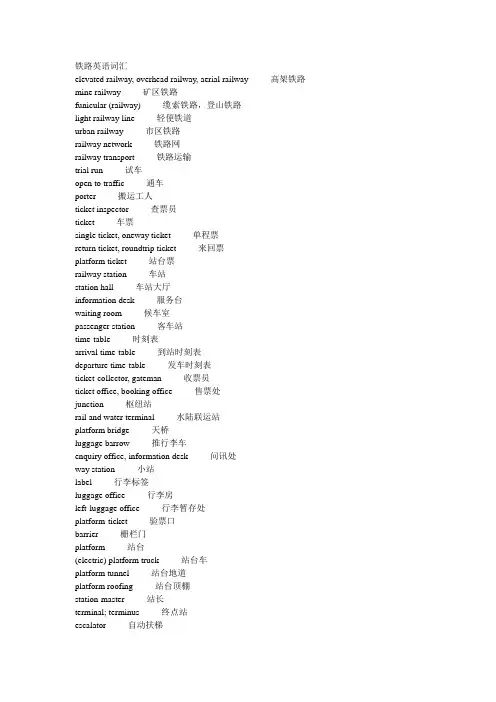
铁路英语词汇elevated railway, overhead railway, aerial railway 高架铁路mine railway 矿区铁路funicular (railway) 缆索铁路,登山铁路light railway line 轻便铁道urban railway 市区铁路railway network 铁路网railway transport 铁路运输trial run 试车open to traffic 通车porter 搬运工人ticket inspector 查票员ticket 车票single ticket, oneway ticket 单程票return ticket, roundtrip ticket 来回票platform ticket 站台票railway station 车站station hall 车站大厅information desk 服务台waiting room 候车室passenger station 客车站time-table 时刻表arrival time-table到站时刻表departure time-table 发车时刻表ticket-collector, gateman 收票员ticket office, booking office售票处junction枢纽站rail and water terminal水陆联运站platform bridge天桥luggage barrow 推行李车enquiry office, information desk 问讯处way station 小站label 行李标签luggage office 行李房left-luggage office 行李暂存处platform-ticket 验票口barrier 栅栏门platform 站台(electric) platform truck站台车platform tunnel站台地道platform roofing 站台顶棚station-master 站长terminal; terminus 终点站escalator自动扶梯The train leaves the station at..., The train is due out at... 火车在(某时)离站to have one's ticket punched(给检票员)检票10 minutes behind schedule晚点十分钟to change trains at... 在(某地)换车The train is due at... 在(某时)到达to break the journey 中途下车dining car, restaurant car, diner 餐车pantry 餐车食品室open wagon, (railway) wagon, (railway) truck 敞车carriage, coach, car 车厢roof车顶concertina walls (车厢通道两侧的)伸缩篷step; foot board (车厢门口的)踏板gangway (车厢的)通道lidded ashtray带盖烟灰盒tank wagon罐车mixed train 混合列车freight train, goods train 货物列车engine, locomotive 机车window seat 靠窗座位coach, passenger train客车express train, express 快车refrigerator wagon 冷藏车car attendant; train attendant 列车员guard, conductor 列车长slow train, way train 慢车covered wagon van, box car 棚车ordinary train 普通列车sleeping carriage with cushioned berths 软卧客车up train 上行车livestock wagon牲畜车sleeping car, sleeper 卧车down train 下行车luggage van, baggage car 行李车rack, baggage rack 行李架sleeping carriage with semicushioned berths 硬卧客车ordinary seat 硬席carriage with semicushioned seats硬座车mail car 邮政车mail and luggage van 邮政行李车through train直达车special train 专车pointsman, switchman 道岔工人signal for blocking the track, block signal 闭塞信号semaphore signal, home signal臂板信号warehouse 仓库siding, sidetrack侧线,旁轨turnout 岔道weighing machine 秤重机derailing (火车)出轨single line (track) rail 单线points, switches 道岔switch lock, point lock 道岔锁wait sign, wait signal 等候标志(信号)marshalling yard, shunting yard调车场dispatching 调度dispatcher 调度员crossover 渡线,转线轨道rail 钢轨track轨道sleeper, railroad tie 轨枕rail chair轨座buffer stop, bumping post 缓冲桩goods shed, freight depot货棚goods station 货运站,货站container 集装箱locomotive (engine) shed 机车库station warning sign 进站预告标clearance 净空(signal) gantry (铁路上支持信号装置的)跨线桥barrier (道口)拦路木section 路段reduce speed sign(al) 慢行标志(信号)bell and whistle sign, whistle sign鸣笛预告标platform car, flat car 平车grade crossing, level crossing(道路与铁路的)平面交叉track-laying machine, tracklayer铺轨机double line (track) rail 双线volume of railway freight 铁路货运量railway connections 铁路交叉点,铁路联络线railway warning sign 铁路警告标志railway clearance铁路净空railroad bed 铁路路基railway curve 铁路曲线(弯道)railway tunnel 铁路隧道railway line, railroad line 铁路线stop sign(al) 停车标志(信号)danger sign(al) 危险标志(信号)unprotected crossing 无防护设备的道口signal light (lamp) 信号灯signal box, signalman's cabin 信号房signalman 信号员wing rail (of frog) 翼轨distant signal, disk signal, target 圆盘信号机back-turning section 折返段frog 辙叉,岔心turn-table 车台,旋车盘point (box), switch (box) 转辙器switch signal, point indicator 转辙信号更多铁路评论请登陆中国铁道论坛(/)。
铁路英语专业词汇铁路英语专业词汇铁路运营长度;运营里程operation length of railway;operating distance; revenue length列车运行图 train diagram铁路建筑长度 construction length of railway区间 section区段 district轨距 rail gage; rail gauge轮重 wheel load轴重 axle load最大轴重 maximum allowable axle load限制轴重 axle load limited限界 clearance; gauge限界图 clearance diagram铁路建筑限界railway construction clearance;structure clearance for railway; railway struction gauge基本建筑限界fundamental construction clearance;fundamental structure gauge 桥梁建筑限界bridge construction clearance; bridge structure gauge隧道建筑界限tunnel construction clearance;tunnel structure gauge铁路机车车辆限界 rolling stock clearance for railway; vehicle gauge机车车辆上部限界clearance limit for upper part of rolling stock机车车辆下部限界clearance limit for lower part of rolling stock装载限界 loading clearance limit; loading gauge阔大货物限界clearance limit for freight with exceptional dimension; clearance limit for oversize commodities 接触网限界clearance limt for overhead contract wire;clearance limit for overhead catenary system;overhead catenary system gauge列车与线路相互作用 track-train interaction轮轨关系 wheel-rail relation; wheel-rail interaction粘着系数 adhesion coefficient车轮滑行 wheel sliding; wheel skid车轮空转 wheel slipping牵引种类 kinds of traction; category of traction牵引方式 mode of traction。
铁路英文词汇Rolling stock termsGB 4549.1-84一、一般名词术语 General1、车辆的种类铁道车辆 rolling stock,railway vehicle,railway car客车 carriage,passeger car货车 wagon.freight car特种车 special car钢木车 steel-wood car全金属车 all metal car全钢车all steel car二轴车 two-axle car四轴车 four-axle car六轴车 six-axle car转向架式车 rogie car关节式车 articulated car动车 motor-car拖车 trailer控制车 controlling car动车组 powered car train-set合造车 combined car简易客车 simply equipped coach代用客车 substitute passenger car双层客车 double-deck coach母车 car with axle generator子车 car without axle generator座车 seat coach硬座车 semi-cushioned seat coach软座车 cushioned seat coach,soft seat coach卧车 sleeping car硬卧车 semi-cushioned berth sleeping car 软卧车 cushioned berth sleeping car餐车 dining car行李车 luggage van,baggage car邮政车 mail van,postal car了望车 observation car公务车 service car,private car文教车 culture and education car医疗车 hospital car卫生车 ambulance car试验车 test car维修车 maintenance car宿营车 dormitory van,train crew car轨道检查车 track inspection car轨道探伤车 rail faults detection car隧道摄影车 tunnel-photographing car限界检查车 structure gauge detection car 检衡车 track scale test car发电车 generator car锅炉车 boiler car救援车 relief car敞车 open-top car,gondola car棚车 covered wagon,box car平车 flat car罐车 tank car守车 caboose, brake van煤车 coal car砂石车 gravel car矿石车 ore car漏斗车 hopper car水泥车 cement car保温车 thermal car隔热车 insulated-cover wagon,insulated box car加冰冷藏车 ice-cooled refrigerator car冷冻板冷藏车 eutectic-ice-cooled refrigerator car加温车 heater car冷藏加温车 refrigerator and heater car机械冷藏车 mechanical refrigerator car单节机械冷藏车 mono-unit mechanical refrigerator car机冷货物车 mechanical refrigerator freight car机冷发电车 mechanical refrigerator generating car机械冷藏车组 mechanical refrigerator car train-set通风车 ventilated car家畜车 live stock car, stock car活鱼车 fish car零担办公车 office car for peddler train毒品车 posion car集装箱车 container car长大货物车 heavy-duty car,high capacity car凹底平车 depressed center flat car落下孔车 well car, well-hole car双联平车 twinned flat car钳夹车 schnabel car自动倾翻车 side dump car除雪车 sweeper, snow plow长钢轨车组 long rail car train-set电站车组 power station car train set车辆纵向 longitudinal direction of car车辆横向 transverse direction of car车端 end of car一位端“B” end of car二位端“A” end of car一位侧 No.1 position side二位侧 No. 2 position side轴位 position of axle轮位 position of wheel梁位 position of sill车钩中心线高 hright fron top of rail to coupler center车辆长度 length of car车辆宽度 width of car车辆最大宽度 max. width of car车辆高度 height of car车辆最大高度 max. height of car车体长度 length over ends of car body底架长度 length of underframe罐体长度 length of tank barrek车体宽度 width over sides of car body底架长度 underframe width车体内长 inside length of car body车体内宽 inside width of car body车体内侧面高 inside height of car body车体内中心高 inside height from floor to roof centre 地板面高 height of floor from rail top车辆定距(心盘中心距) length between bogie pivot centers车辆全轴距 total wheel base of car车辆定距比 ratio of car body length to length between bogie centres换长 equivalent length旁承间隙 side bearing clearance自重tare weight载重 loading capacity整备品重 servicing weight总重 gross weight自重系数coefficient of tare weight,tare-to-load capacity每延米重load per meter of track簧上重量suspended weight,weight above spring簧下重量non-suspended weight,weight under spring构造速度design speed通过最小曲线半径 min. radius of curvature negotiated动力系数coefficient of kinetic force振动舒适度comfortable quality of vibration平稳性指标(振动舒适度指标)index of running stability倾复稳定性security of over turing from track脱轨稳定性security of derailment6、其他空车empty car轴数number of axle车辆标记lettering and marking of car 车辆型号model of car车辆号码serial number of car定员seating capacity技术履历簿technical ancestry book吊hanger卡clamp,clip吊卡anchor,suspension座seat,rest,bracket吊座hanger bracket托carrier,support,bearer环ring链chain连接板connecting plate补强板reinforcing plate筋板rib隔板partion plate撑板staying plate托板supporting plate固定板fastening plate压板pressing plate吊板hanging plate支承板bearing plate垫板shim,pad调整板adjusting plate限制板locating plate挡板baffle plate防跳板anticreep plate护板shield plate防尘板dust guard plate磨耗板wear plate防火板fireproof plate盖板cover plate腹板web plate翼板flange plate地板floor plate顶板roof plate墙板side plate装饰板decorating plate饰带板lining根据位置不同所用板plate used in other place 节流板moderating plate,limiting plate垫shim,pad,liner,washer盖cap,cover,lid阀valve体body梁girder,sill,beam,stringer柱post斜撑diagonal brace压条cornice,molding,treadle bar承木wooden parting stringer,nailing strip 隔热材料heat-insulating material二走行装置二走行装置running gear1 一般走行装置running gear转向架bogie,truck二轴转向架two-axle bogie三轴转向架three-axle bogie组合转向架combination bogie导框式转向架pedestal bogie导框式转向架non-pedestal bogie导框式转向架pedestal bogie整体侧架转向架bogie with integral box side frame构架frame,bogie structure侧架bogie side frame轮对wheel set有箍车轮tyred wheel整体车轮solid wheel碾钢车轮wrought steel wheel,rolled steel wheel轴箱journal box承载鞍adapter轴箱定位装置box guidance弹簧减振装置spring and vibration absorber device弹簧悬挂装置suspension damper弹簧装置spring device轴箱弹簧装置journal spring device摇枕弹簧装置bolster spring device轴箱弹簧journal spring摇枕弹簧bolster spring均衡弹簧equalizer spring空气弹簧air spring橡胶弹簧rubber spring第一系弹簧装置primary suspension第二系弹簧装置secondary suspension一系弹簧装置single-stage suspension二系弹簧装置two-stage suspension自动高度调整装置automatic height ajuster减振器vibration absorber摩擦减振器snubber油压减振器hydraulic damper旁承side bearing滑块式旁承sliding block side bearing摆块式旁承pendulum side bearing滚子式旁承roller side bearing液压旁承hydraulic siide bearing气液旁承hydro-pneumatic side bearing转向架基础制动装置bogie brake rigging踏面制动tread braking盘形制动disc braking,rotor braking单侧制动signle side braking双侧制动clasp braking制动梁brake beam闸瓦brake block,brake shoe闸片brake ling中磷闸瓦medium phosphor brake shoe高磷闸瓦high phosphor brake shoe合成闸瓦composite brake shoe制动盘braking disc心盘面自由高free height from rail top to centre plate wearing surface转向架对角线bogie diagonal轴距wheel base固定轴距fixed or rigid wheel base转向架全轴距total wheel base of bogie assembly轮对内侧距distance between backs of wheel rims轴颈中心距distance between acting centres of journal load踏面tread踏面斜度tread taper踏面基点taping point滚动圆rolling tread circle车轮直径wheel diameter轮箍厚度tire thickness轮辋内侧厚度rim inside thickness轮辋外侧厚度rim outside thickness轮辋宽度rim width轮缘高度flange height轮缘高度测定线flange base line轮缘厚度flange thickness轮毂直径diameter of boss轮毂厚度boss thickness轴箱导框间隙pedestal clearance with pedestal guide摇枕挡间隙column guide cleatance with the column轴载荷axle loading force轴荷重axle load轴重wheel set load心盘载荷centre plate loading force旁承载荷side bearing loading force斜对称载荷obliquely symmetrical loading force弹簧静挠度static deflection of spring弹簧动挠度dynamic deflection of spring弹簧挠度裕量surplus deflection of spring,reserve deflection of spring挠度裕量系数reserve coefficient(or surplus factor) of spring deflection转向架扭曲刚度bogie against distortion rigidity摩擦减振器相对摩擦系数relative friction coefficient of snubber油压减振器阻力系数damping coefficient of hydraulic damper减振指数damping index临界阻尼值critical damping value脱轨系数coefficient of derailment轴温axle temperature轮缘垂直磨耗vertical wear on flange踏面擦伤scotching on wheel tread踏面剥离flaking on wheel tread2、转向架构架 bogie structure发电机吊架genertor hanger support缓解弹簧座release spring bracket闸瓦托吊座brake head hanger bracket安全吊座safety hanger bracket固定支点座fixed fulcrum bracket端梁end sill侧梁side sill纵向梁longitudinal sill辅助梁auxiliary transom摇枕吊耳bolster hanger lug横梁transom闸瓦托吊耳brake head hanger lug3 转向架侧 bogie side frame轴箱承台pedestal journal roof上斜弦梁top oblique chord检查孔inspection hole斜楔挡friction wedge stop上弦梁top chord立柱column轴箱挡pedestal leg制动梁滑槽brake beam guide下弦梁bottom chord弹簧承台spring seat凸脐spring seat boss摇枕孔bolster opening下斜弦梁bottom oblique chord轴箱导框pedestal4 摇枕及弹簧装置bolster and spring device 弹簧托梁spring plank carrier摇枕吊bolster hanger摇枕吊销bolster hanger pin摇枕吊销座bolster hanger pin seat油压减振动器hydraulic damper,oil damper弹簧夹板spring button摇枕弹簧(外圈)bolster spring(outer)摇枕弹簧(内圈)bolster spring(inner)下旁承体bogie side bearing base下旁承胶垫bogie side bearing rubber pad下旁承滑块bogie side bearing sliding block摇枕挡bolster guide下心盘bogie centre plate中心销centre pin摇枕bolster下旁承bogie side bearing横向缓冲器lateral buffer横向拉杆lateral connecting rod摇枕板弹簧bolster double elliptic spring弹簧托板spring plank安全吊safety hanger摇枕吊轴bolster hanger shaft5 摇枕bogie bolster斜楔摩擦面bolster friction wedge pocket slope凸脐spring seat boss心盘安装面centre plate location排水孔draining hole中心销孔centre pin hole固定杠杆支点安装面dead lever fulcrum bracket location 下旁承座bogie side bearing seat摇枕挡column guide6,7 轮对轴箱及弹簧装置wheel set,journal box and spring device后挡板rear guard油卷lubricating pad前枕front guard轴箱盖box lid轴瓦垫journal bearing wedge轴箱体journal box body轴瓦journal bearing防尘板dust guard,dust shield车轴皮带轮axle belt pulley车轴axle车轮wheel防尘挡圈dust guard ring滚动轴承roller bearing弹簧支柱spring guide-post定位套locating bush轴箱弹簧journal spring支持环spring guide缓冲胶垫rubber pad轴箱后盖journal box rear cover轴箱体journal box body紧定螺母set nut防松板locking plate轴箱前盖journal box frim cover均衡弹簧座equalizing spring seat轴箱导框pedestal均衡弹簧(内圈、中圈、外圈)equalizing spring(inner,intermediate,outer)均衡梁equalizer轴箱托板journal box tie bar轴箱导框磨耗板pedestal wear plate8 轮对wheel set车轴axle车轮轮箍tire,tyre车轮扣环retaining ring车轮轮心wheel centre整体车轮solid wheel9 车轴axle中心孔centre hole轴颈前肩hournal front fillet轴颈后肩journal rear fillet轮座前肩wheel seat front fillet轮座后肩wheel seat rear fillet轴中央部axle middle portion轴身axle body轮座wheel seat防尘板座dust guard seat轴颈journal轴领collar10 整体车轮solid wheel辐板web plate轮缘flange轮毂孔wheel hub bore轮毂hub,boss轮辋rim踏面thread辐板孔web plate hole11 轴箱体journal box body前壁front wall内顶journal box roof轴箱口journal box opening雨檐eaves瓦垫挡journal bearing wedge stopper 承台座pedestal seat底部bottom排水槽draining slot轴箱盖耳孔座journal box hinge lug 后壁rear wall防尘板槽dust guard slot瓦耳挡bearing lug guard侧壁side wall导槽pedestal guide12 油压减振器hydraulic damper压板pressing plate胶垫rubber fitting垫板pad套sleeve密封盖seal cap密封圈seal ring密封衬垫seal ring retainer螺母nut密封弹簧seal spring导向套guide bush缸端盖cylinder end cap缸体cylinder body防尘罩dust protector活塞piston芯阀key valve阀套valve bush阀座valve seat阀瓣valve clack进油阀座oil inlet valve seat 储油缸oil storage cylinder13 转向架基础制动装置bogie brake rigging制动梁brake beam制动梁缓解弹簧brake beam release spring闸瓦托吊brake head hanger固定杠杆dead lever拉杆间隙调整器pull rod type slack adjuster 制动梁拉杆brake beam pull rod移动杠杆live lever上拉杆导轮托top connecting rod guide移动杠杆上拉杆live lever top connecting rod 拉杆connecting rod移动杠杆拉杆吊live lever conection hanger 闸瓦插销brake shoe key闸瓦brake shoe闸瓦托brake head闸瓦间隙调整器brake shoe slack adjuster拉环brake beam and lever connection移动杠杆拉杆live lever connection闸瓦托调整簧brake head spring卡板catch plate压板button调整板adjusting plate调整螺杆adjusting screw调整弹簧adjusting spring调整螺母adjusting nut14 制动梁brake beam滚子roller滚子轴roller shaft下拉杆安全吊lower connecting rod safety link支柱strut弓形杆tension rod槽钢梁compression channel内挡箍inner check ring闸瓦托brake head端部磨耗板end wear plate15 轴端发电装置axle-end drive generating equipment调整手轮锁紧螺母adjusting hand wheel lock nut调整手轮adjusting hand wheel调整弹簧垫adjusting spring guide调整弹簧adjusting spring调整弹簧座adjusting spring seat调整丝杠adjusting lead screw连接轴connecting shaft连接轴紧固螺母connecting shaft sernut密封前盖front seal cap挡尘板dust guard皮带轮belt pulley挡盖guard cap电机托cenerator bracker客车发电机generator for passengercar调整杠杆adjusting lever。
铁道车辆英语单词11.air brake 空气制动Pneumatic brakes气力制动Release 缓解brake releaseHold保压Main reservoir总风缸Driver’s brake valve制动阀Feed valve给风阀Brake pipe列车管Brake rigging制动装置Auxiliary reservoir副风缸Brake block闸瓦Triple valve三通阀Slide valve滑阀kinetic energy动能compressor压缩机angle cocks折角塞门coupled hoses连接软管lap中立distributor分配阀secondary suspension spring二系悬挂弹簧equaliser bar suspension均衡式悬挂rubber suspension橡胶悬挂air suspension空气悬挂braking制动brake application Emergency air brake紧急空气制动Electro-pneumatic brake电控制动Dynamic braking动力制动Regeneration braking再生制动Rheostatic braking电阻制动relay valve中继阀brake cylinder制动缸equalising reservoir 均衡风缸partial release 部分释放vehicle suspension车辆悬挂leaf steel springs叠板弹簧underframe底架,底框steel strap钢带vertical movement垂向振动primary suspension一系悬挂装置secondary suspension二系悬挂装置screwed spring螺旋弹簧spring plank弹簧托板Axle load 轴重9.Centre of gravity重心Bolster;swing bolster摇枕unsprung mass簧下质量wheel tread brakes踏面制动suspension gear悬挂装置wheelset轮lateral damper横向减振器transmission传输brake equipment制动装置quill drive空心轴驱动bogie transom转向架横梁primary suspension coil一系悬挂钢弹簧motor suspension tube牵引电机悬挂梁gear box齿轮箱lifting lug吊耳neutral section switch detector中性段开关探测器self-steering自导向side bearer旁承cardan driving device万向轴驱动narrow-gauge窄轨Centre pivot中心销Bolster springs摇枕弹簧Longitudinal anti-yawing damper纵向抗蛇形减震器Traction transfer device牵引装置Coil springs螺旋弹簧Bogie frame转向架构架Cross beams横梁Seamless steel pipes无缝钢管Axle box suspension轴箱悬挂Pedestal swing spring type摆动式定位Leaf spring type拉板定位Coil spring with cylindrical laminated rubber type橡胶堆螺簧定位Conical laminated rubber type圆锥橡胶堆定位Roll rubber type橡胶筒定位Axle beam type转臂定位Tread踏面Brake shoes闸瓦Flange轮缘Brake cylinder制动缸Wheel slide protection(WSP)system车轮滑行保护系统Shock absorb减震器Axle box cover轴箱盖Steering bogie径向转向架Tilting bogie摆式转向架Tread gradient踏面斜度track irregularities轨道不平顺结ride comfort乘坐舒适rotational displacement转动位移structure and performance 构与性能suspension gear悬挂装置frame mounted motor电机架悬Tare、tare weight皮重Sleeper car卧铺车Combine car复合车passenger car客车freight car货运车flat car平车container car装箱车dining car餐车Dome car圆顶车Luggage Cart行李车Boxcar棚车Housing car封闭车Open top car开顶车Refrigerator car保温车,冷藏车Stock car运牲口火车车辆Flat car平台货车,无盖货车Hopper漏斗车Gondola Cars敞车Caboose守车Tank罐车Railway psot office(RPO)邮政车Bogie转向架Double decker passenger train双层旅客列车railway coach铁路列车observation cars观光车truck wheel base车轴距seating capacity可容纳,座位数目antiskid 防滑装置clearance limit限界rolling stock机车车辆Depressed-center flat car . 凹底平车railway loading guage铁路装载限界double banked双编组diesel multiple unit柴油车组wheel rim辋the drawbar pull车钩牵引力hotel power空调compression ratio压缩比bedplate机座the bottom of the downstroke下止点upstroke上行冲程the top of the stroke上止点rim轮缘radiator散热器radiator fans散热器风扇high pressure air cylinders高压风缸flyweights飞块filter过滤器diesel engine柴油发动机gasoline engine汽油发动机tractive effort牵引力drawbar pull and power牵引力和功率governor调节器cam凸轮throttle vavle节流阀Four-stroke diesel engine四冲程柴油机fuel injection燃油喷射lubrication润滑cooling冷却Roadbed路基slab石板baulk木梁unprecedented空前的penetrate 穿透看透Backhome 意志力中枢foreseeable 可预知的turnout 道岔crosstie枕木Subgrade地基路基stratum 地层embankment堤坝trackbed道床ballast道咋Subballast 地层道咋sleeper 轨枕earthworks土木工程drainage排水Corridor走廊crossing平交道口railroad cars 铁道车辆multiple unit动车组Coach客车cable缆索钢丝绳corresponding 相应的atmospheric大气的Monorail单轨铁路rubber-tired underground橡胶轮地铁funicular索道Cog嵌齿freight货车passenger train旅客列车tilt倾斜centrifugal force离心力inter-city train城际列车Halt停止前进local train管内列车普快stopper慢车suburb市郊Double-decked passenger train双层客运列车conurbation有卫星城的大都市Emergency brake handle紧急制动手柄metro地铁level crossings平交道口Tram电车light rail轻轨铁路streetcar有轨电车commuter train市郊列车Cargo货物container集装箱crane起重机box wagon棚车Bulk散装stow装卸siding旁轨crew乘务人员infrastructure下部构造Heavy freight重载货运platform站台terminal终点站buffer stop车挡Crossover道岔run-aroud tarck调车线scissors crossover双开渡线Electric traction电力牵引auxiliary辅助的motor car动力车driving cab司机室Coupler车钩beam梁loop圈guiding导向disconnected分离的Bolt螺钉slack松弛的cushioning减震缓冲chain链条knuckle指节Coupling pole 车钩提杆wagon货车jaw钩舌uncouple 解开Pedal踏板pneumatic由压缩空气推到的articulated铰接generator直流发电机alternator交流发电机motor blower牵引电动机通风机inverter整流器compressor压缩机truck frame转向架构架pantograph受电弓converter变流器transformer变压器axle load轴重max. operation speed最大运用速度overall dime外形尺寸total wheel base全轴距drive shaft传动轴air intakes进气口control stand控制站man-machine interface人机界面fuel tank油箱,燃油箱reduction gear减速器turbo charging涡轮增压armature衔铁coils线圈Min negotiable curve radius最小通过曲线半径Oil radiator散热器润滑油Main circuit主电路Armature winding电枢绕组Clutch抓住Camshaft凸轮轴Diode二极管Semi-conductor半导体Smoothing滤波Freewheel diode续流二极管Armature电枢Commutator换向器Gearwheel大齿轮Rotor转子Synchronous同步asynchronous motor异步电机thyristor晶闸管Carbon brush碳刷Induction motor感应电机Traction power牵引力Steam locomotives蒸汽机车Diesel-mechanical locomotive内燃机械传动机车Diesel-electric locomotives内燃电传动机车Disease-hydraulic locomotives柴油机液力传动机车Gas turbine locomotives气涡轮机车Magnetic levitation locomotive磁悬浮机车Gearbox变速箱Three phase三相Open motor开敞性电动机Diesel locomotive内燃机车Electric locomotive电力机车Diesel柴油机three-phase alternator三相交流发电机Regenerative braking 再生制动main-line主线generator发电机centrifugal pump离心泵switcher locomotive调车机车motive power(原)动力traction power牵引动力。
枕木sleeper轨枕crossing平交道口multiple unti动车组high-speed railways高速铁路maglev磁力悬浮火车centrifugal force 离心力emergency brake handle 紧急制动手柄metro地铁light rail轻轨铁路commuter train通勤车tanker罐车operation 运转操作infrastructure下部构造platform站台EMU电力牵引动车组DMU内燃牵引动车组cushioning减震缓冲electricity-air control 电空控制antiskid防滑装置bolster枕rotational resistance回转阻hunting蛇行narrow-gauge窄轨bolster springs摇枕弹簧damper减震器阻尼器longitudinalanti-yawing dampers纵向抗蛇行减震器disc brakes 盘形制动traction transfer device 牵引装置wheel tread brakes踏面制动tread gradient踏面斜self-steering自导向V ehicle Suspension车辆悬挂cushion system缓冲装置vertical movement垂向振动primary suspension一系悬挂装secondary suspension 二系悬挂装置车钩coupler摇枕bolster乘务员crew轴箱axlebox棚车boxcar封闭车housing car保温refrigerator car牲畜车stock car漏斗车hopper罐车tank car集装箱container车体carboy复合车combine car邮政车railway post office圆顶车dome转向架bogie瞭望车observation car缓冲器draft gear行李车baggage car卧铺车sleeping car旁承side bearer制动缸brake cylinder侧梁side beams横梁cross beamscrosstie敞车gondola 英译汉1.The basic design of apassenger car hasn”t changed muchsince the middle of the 19thcentury,but there are severaldifferent passenger car types inservice around the world.2.自19世纪中期以来,客车的基本设计没有发生多大改变,但仍有不同形式的客车在全世界范围内使用。
Cut wheel fracture problems and maintenance costsJorg Villmann looks at the problems of wheel fracture and the development of new designs to reduce failure problems and maintenance costs.In the late 1960s and 1970s axel loads and speeds of railway vehicles increased rapidly. This led to higher thermal an mechanical loads of the wheels. Tiered wheels showed loose types after strong heating during runs on mountainous lines or following to brake irregularities. Maintenance costs for type changing increased more and more.In order to solve these problems solid wheels were introduced. The most common used wheel type was the so-called ORE wheel developed by the European railways under the roof of the ORE (today European Rail Research Institute ERRI) as the research institute of the UIC (International Union of Railways).Following the extended use of solid wheels in connection with a block brake, the unforeseen problem of wheel fracture occurred. Investigation of failured wheels showed that two principal forms of wheel fracture occurred - radial fracture from the wheel rim straight through the web down to the hub or beginning in the rim, running straight in to the web and shared in two branches. It was also found that the fracture was initiated fromhalf-elliptical or fourth-elliptical fatigue cracks, which started on the tread, around the chamfer or due to sharp notches from clamping devices of reprofiling lathes.Detailed investigation showed that all failured wheels were thermally damaged and had high residual tensile stresses in the rim of about 300 MPa. Though the number of failed wheels was relatively small each failure could lead to devastating consequences. Therefore intensive research work was carriued out to improve this situation.Research programmeThe European Rail Research Institute (ERRI), which is part of the UIC, was selected to lead the project work. The committee responsible for the work was the B 169 specialists committee. Three major problems were considered work programme :* Monitoring of the wheels in service.* Improvement of material characteristics.* Improvement of the residual stress level and the displacement behaviour .With the first problem it was important to summarise the experience of the different railways and to get more detailed knowledge of the condition of the wheels in service. These investigations confirmed the results concerning the residual stresses. Approximately 10 per cent of the wheels had residual stresses of about 300 MPa. On the other hand, the fracture toughness KIC or KQ of the wheels investigated was between 40 and 70 MPa. From fracture mechanics calculation it could be concluded that approximately 10 per cent of the wheels had a potential risk of failure . The analysis also brought up some cases of fatigue cracks in the wheel web and many cases of unacceptable lateral displacements of the wheel rim leading to high maintenance costs.Therefore the first step was to set-up rules for monitoring of the wheels in service including acceptance criteria. The B169 specialists committee developed fourcharacteristics for visual inspection to identify potential wheels thermally overloaded . Criteria for the assessment of the wheels undergoing maintenance were also defined. Wheels with thermal damages must undergo residual stress measuring and, if required, crack detection. The whole procedure is defined in 4. Following to the implementation of the in-service rules and the continuous monitoring an essential reduction of wheel fracture was reached in Europe.In order to be independent from detailed maintenance rules and in-service monitoring, research then focused on the improvement of the wheel material. The results can be summarized as follows5:* Normally no KIC values were found, that are KQ values.* KQ is suitable to describe the material characteristics,.* KQ between 70 and 85 MPa is achievable for steel grade R7T.The third step focused on the reduction of the residual tensile stress level in the rim and on the lateral displacement of the rim. In this regard the shape of the wheel web is essential. Therefore different proposals were developed by the wheel producers and were tested under the roof of the ERRI research programme . Generally it can be stated that a more flexible wheel web is suitable to reduce the residual tensile stresses in the rim. On the other hand it is also possible to hold the displacements in a small tolerance band.RequirementsAs a result of the research work, a number of new requirements for wheel material and wheel design were defined. These requirements led to new or revised international specifications. The material requirements are defined in UIC-leaflet 812-36 and recently in the European standard EN 132627. For R7T steel grade (or ER7T according to EN 13262) a fracture toughness KIC or KQ of 80 MPa (mean value) and 70 MPa (minimum value) is required. For ER6T the corresponding requirements are 100 MPa (mean value) and 80 MPa (minimum value) given in EN 13262.Regarding the wheel design requirements the UIC published the new UIC leaflet 510-58 which was prepared by the ERRI B 169 specialists committee. This document is also the basis for the development of a new Draft European standard prEN 13979-1 which is in preparation now. The new standards are built up as a specification giving more freedom to the designer. According to these specifications four aspects of a new wheel design have to be considered:* Geometrical aspect: to allow interchangeability.* Thermo mechanical aspect: to manage wheel deformation and to ensure that braking do not induce wheel failure.* Mechanical aspect: to ensure that no fatigue crack in the web will occur.* Acoustical aspect: to ensure that the solution is better or equal compared with a reference wheel.Concerning the interchangeability requirements in three ways are necessary depending on the customer1:* Functional requirements, e.g. wheel diameter, tread profile, asymmetry of the hub withregard to the rim.* Fitting requirements, for example, length of the hub, bore diameter.* Maintenance requirements, e.g. clamping conditions of the wheelset reprofiling lathes.The designer has full freedom regarding the design of the wheel web.For railway vehicles with block brakes the brake power has to be considered. Tests with freight trains running on long mountainous lines through the Alps received an average brake power level of 50kW for a wheel with 920mm diameter. For smaller wheels the brake power is on a corresponding lower level. Therefore wheels for freight wagons have to resist these brake loads.For vehicles with different brake systems, such as disc brakes, an assessment of the thermal behaviour is not necessary. For combined brake systems (block brake and others) modified loads shall be agreed between customer and supplier.The brake loads are reproduced on a brake test bench. In order to check the thermal behaviour the wheel is loaded with a number of brake cycles. For the assessment unified criteria are defined in UIC 510-5 and prEN 13979-1 respectively. For the level of residual tensile stresses in the rim the following criteria are valid: For a wheel with its nominal diameter a stress level of maximum 200MPa (mean value) and maximum 250MPa (for each cross section) is acceptable. For a wheel with its diameter near the wear limit a stress level of maximum 275 MPa (mean value) and maximum 300 MPa is acceptable. Regarding the lateral displacement the analysis of maintenance rules, of the service experience and of the dimension of crossings and points led to allowable values between -1 mm and +3 mm (during braking) and between -0.5 mm and +1mm (in cold condition).For the mechanical aspect8 determine a relative conventional procedure. First step is a stress calculation using the finite element method. Three conventional load cases are to be considered representing straight track full curves and points and crossings. Based on these loads the normal stresses for each node of the FE mesh is calculated. Comparing the stresses for the different load cases a stress range or a stress amplitude can be calculated. The stress of the most stressed node shall be compared with the decision criteria, which are ±180 MPa for wheels with fully machined web and ±145 MPa for wheels with unmachined web. In addition to the calculation fatigue tests can be required. This depends on the results of the calculation and on the validity of the conventional loads. Two methods for fatigue tests are possible, either a random fatigue test or a one-stage fatigue test8. For both methods the test loads are derived from measured loads during field tests.Concerning the acoustical aspect it is, of course, not a target that new developed wheels have higher sound radiation compared with existing designs. Therefore a sound level is described which is comparable with the former ORE standard wheels8. The sound level can be determined by a calculation. The acoustical requirements are informative only.Product development and verificationThe stress ranges for the various designs are calculated as follows:* Wheel 21.061.00 (BA 004)/21.061.10 (BA 304) ±240.9 MPa (25 t axle load),* Wheel 21.431.01 (BA 378) ±175.9 MPa,* Wheel 21.430.01 (BA 375) ±168.9 MPa,* Wheel 21.463.00 ±185.2 MPa (exceptional lateral forces for the calculation required).Therefore for the wheel designs 21.061.00 (BA 004)/21.061.10 (BA 304)and21.463.00 additional fatigue tests are necessary. The results of both fatigue tests and field tests showed sufficient mechanical characteristics.ConclusionDue to increased service loads especially increased thermal loads, Radsatzfabrik Isenburg GmbH developed a family of wheel designs for different applications. They meet the requirements of the new or revised specifications. Up to now no failure of these designs occurred. The residual stress level is lower compared with the former designs. Therefore the residual stress measurement during the maintenance can be cancelled. Due to the low lateral displacements no wheelset has to be replaced. The wheels meet the interchangeability requirements ensuring an easy change of wheels. The new designs help the customer to reduce maintenance costs. For the future modifications of Radsatzfabrik's designs are possible depending on specific customer requirements.车轮断裂问题及维修费用Jorg Villmann研究车轮断裂问题,开发新的设计,以降低故障维修费用问题。